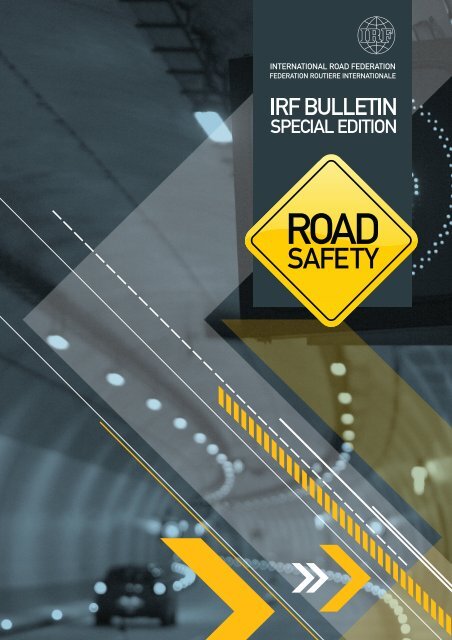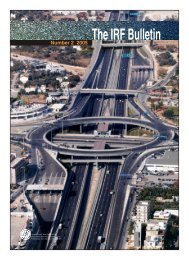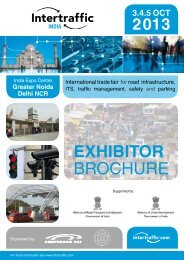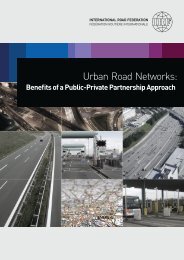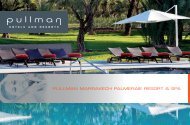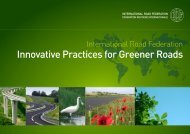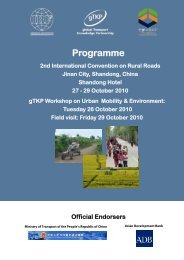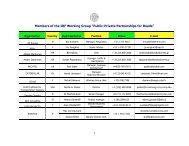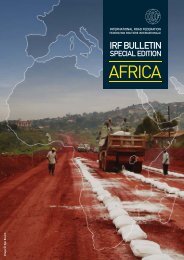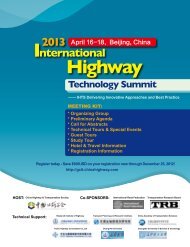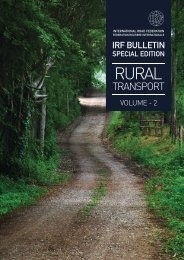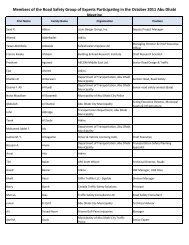IRF's first bulletin fully devoted to the issue of road safety and
IRF's first bulletin fully devoted to the issue of road safety and
IRF's first bulletin fully devoted to the issue of road safety and
You also want an ePaper? Increase the reach of your titles
YUMPU automatically turns print PDFs into web optimized ePapers that Google loves.
page00cover.pdf 10/12/2007 1:54:25 PM<br />
C<br />
M<br />
Y<br />
CM<br />
MY<br />
CY<br />
CMY<br />
K
page01.pdf 10/12/2007 1:07:09 PM<br />
C<br />
M<br />
Y<br />
Credits <strong>and</strong> Acknowledgments<br />
Contributing Edi<strong>to</strong>r:<br />
Tim Goodyear IRF Geneva<br />
IRF BULLETIN<br />
SPECIAL EDITION<br />
ROAD<br />
SAFETY<br />
Editing <strong>and</strong> Supervision:<br />
Tim Goodyear - Communications IRF Geneva<br />
Maria Novikov - Project Manager IRF Geneva<br />
Susanna Zammataro - Project Manager IRF Geneva<br />
Graphic Design & Layout: Digitalgrafis Studio, Indonesia<br />
The IRF would like <strong>to</strong> thank <strong>the</strong> following for supplying articles,<br />
charts, comments <strong>and</strong> pho<strong>to</strong>graphs for this publication: Jean<br />
Beauverd (Colas Switzerl<strong>and</strong>), Peter J. Boyd (Delcan, Canada), Mike<br />
Dreznes (IRF Washing<strong>to</strong>n), Rik Nuyttens (3M Europe), Hans-Joachim-<br />
Vollpracht (PIARC Technical Committee Road Safety), Elena de la<br />
Peña (Spanish Road Association), Richard Harris <strong>and</strong> Tim Cuell<br />
(WSP Group), Dr. Madaniyo Mutabazi (University <strong>of</strong> <strong>the</strong> West<br />
Indies, Trinidad & Tobago), J.-Pierre Henrat (Colas France), Francis<br />
Letaudin <strong>and</strong> Jean Luc Aubert (SACER), Jean-Claude R<strong>of</strong>fe (Colas<br />
France), Maria Novikov (IRF Geneva).<br />
Publisher:<br />
INTERNATIONAL ROAD FEDERATION<br />
FEDERATION ROUTIERE INTERNATIONALE<br />
IRF Geneva<br />
2 chemin de Bl<strong>and</strong>onnet<br />
CH-1214, Vernier/ Geneva, Switzerl<strong>and</strong><br />
Tel : + 41 22 306 02 60 Fax : + 41 22 306 02 70<br />
info@irfnet.org<br />
IRF Washing<strong>to</strong>n<br />
Madison Place<br />
500 Montgomery Street, 5th Floor, Alex<strong>and</strong>ria, USA<br />
Tel: + 1 703 535 1001 Fax: +1 703 535 1007<br />
info@irfnews.org<br />
IRF Brussels<br />
Avenue Louise, 113<br />
B-1050, Brussels, Belgium<br />
Tel : + 32 644 58 77 Fax : + 32 647 59 34<br />
info@irfnet.eu<br />
www.irfnet.org<br />
CM<br />
MY<br />
CY<br />
CMY<br />
K<br />
NEW<br />
EDITION<br />
You are in <strong>the</strong> driving seat on <strong>road</strong> investments ...<br />
You plan safer <strong>road</strong>s ...<br />
You research <strong>road</strong> trends over 40+ years,<br />
140+countries <strong>and</strong> various vehicle types ...<br />
Benchmarking is second nature <strong>to</strong> you ...<br />
You seek <strong>the</strong> best <strong>road</strong> data from one unique<br />
source ...<br />
SO YOU NEED TO ORDER<br />
NOW YOUR COPY OF THE ...<br />
IRF<br />
WORLD<br />
ROAD<br />
STATISTICS<br />
2007<br />
DATA 2000-2005<br />
Email: info@irfnet.org Tel: 041 22 306.02.60<br />
Website: www.irfnet.org
page02.pdf 10/12/2007 1:49:51 PM<br />
Welcome <strong>to</strong> <strong>the</strong> second IRF Bulletin Special Edition <strong>of</strong> 2007.<br />
In <strong>the</strong> <strong>first</strong> edition - on <strong>the</strong> environment - we examined <strong>the</strong> degree <strong>to</strong> which current<br />
levels <strong>of</strong> mobility are sustainable, however vital <strong>the</strong>y may be for <strong>the</strong> world economy in<br />
general <strong>and</strong> isolated communities in particular.<br />
Jean Beauverd<br />
We concluded that <strong>the</strong>y are not sustainable if we - <strong>and</strong> I include <strong>the</strong> entire <strong>road</strong><br />
transport sec<strong>to</strong>r in my choice <strong>of</strong> pronoun - ignore <strong>the</strong> effects <strong>of</strong> our activities on <strong>the</strong><br />
natural environment. But we also concluded that <strong>the</strong>re are many things that we are<br />
doing, can do <strong>and</strong> must do, for <strong>the</strong> future, <strong>to</strong> guarantee sustainable mobility for all.<br />
The same principles apply <strong>to</strong> our choice <strong>of</strong> subject for this special edition: <strong>road</strong> <strong>safety</strong>.<br />
That choice is - if you will excuse <strong>the</strong> English pun - "no accident." The environment<br />
<strong>and</strong> <strong>road</strong> <strong>safety</strong> are uppermost in nearly everyone's mind, when <strong>road</strong> transport is<br />
under discussion. We can assert <strong>the</strong> economic benefits <strong>of</strong> <strong>the</strong> sec<strong>to</strong>r as much as we<br />
like but those benefits tend <strong>to</strong> be taken for granted, whe<strong>the</strong>r we like it, or not.<br />
What we, <strong>the</strong> <strong>road</strong> construc<strong>to</strong>rs, must do is concentrate - as <strong>the</strong> winners <strong>of</strong> this year's<br />
IRF <strong>road</strong> <strong>safety</strong> awards have done - on <strong>the</strong> "four Es" <strong>of</strong> excellence. As with all<br />
worthwhile endeavours, what is needed is collaborative effort between all <strong>the</strong> players.<br />
The search for excellence encompasses aspects <strong>of</strong> engineering (where <strong>road</strong> design <strong>and</strong><br />
<strong>road</strong> materials used are critical), education, enforcement <strong>and</strong> encouragement.<br />
C<br />
M<br />
Y<br />
That message emerges strongly from <strong>the</strong> pages <strong>of</strong> this second special edition <strong>of</strong> our<br />
<strong>bulletin</strong>.<br />
CM<br />
MY<br />
CY<br />
CMY<br />
K<br />
Jean Beauverd<br />
President <strong>and</strong> CEO, Colas Switzerl<strong>and</strong><br />
Chairman <strong>of</strong> <strong>the</strong> IRF Geneva Programme Centre<br />
A Word from <strong>the</strong> IRF<br />
World Executive Board Chairman<br />
Road accidents affect all our lives. Road transport is a near-universal activity <strong>and</strong> none<br />
<strong>of</strong> us remain un<strong>to</strong>uched by its negative physical impacts - be <strong>the</strong>y <strong>the</strong> trivial effects <strong>of</strong><br />
a "fender bender" or <strong>the</strong> tragic consequences <strong>of</strong> a fatality. If <strong>the</strong> worldwide <strong>to</strong>ll <strong>of</strong><br />
<strong>road</strong> accidents, reliably estimated <strong>to</strong> be one million deaths per annum, arose from <strong>the</strong><br />
effects <strong>of</strong> a medical condition, <strong>the</strong>n <strong>the</strong> world's news headlines would be dominated<br />
by that <strong>to</strong>ll. Undoubtedly, <strong>the</strong> UN's World Health Organization would take a<br />
quantum leap until <strong>the</strong> condition had been eradicated.<br />
Peter J. Boyd<br />
Chairman, Advisory Board<br />
Delcan, Toron<strong>to</strong>, Canada<br />
To those that say eradication <strong>of</strong> fatalities <strong>and</strong> serious injury is impossible, please<br />
consider <strong>the</strong> words <strong>of</strong> Robert Browning, "... man's reach must exceed his grasp, or<br />
what's a heaven for" To reach for <strong>the</strong> goal <strong>of</strong> eradication is <strong>the</strong> duty <strong>of</strong> us all.<br />
Peter J. Boyd
page03.pdf 10/12/2007 1:01:07 PM<br />
CONTENTS<br />
04<br />
Introduction<br />
The IRF is <strong>the</strong> only world forum advocating better <strong>and</strong> safer <strong>road</strong>s through better <strong>road</strong><br />
design. Given its members' rich expertise in <strong>road</strong> <strong>safety</strong> engineering measures, IRF is in<br />
an ideal position <strong>to</strong> initiate <strong>road</strong> <strong>safety</strong> projects aimed at improved <strong>road</strong> infrastructure.<br />
06<br />
Signing, Road Design <strong>and</strong> Attention <strong>to</strong> User Groups<br />
Road <strong>safety</strong> improvements will be achieved through holistic approaches, covering <strong>road</strong>s,<br />
vehicles <strong>and</strong> particular users. Look at three examples <strong>of</strong> <strong>the</strong>se approaches - covering <strong>the</strong><br />
application <strong>of</strong> signing in accident black spot management, an analysis <strong>of</strong> what<br />
constitutes <strong>the</strong> "forgiving <strong>road</strong>", <strong>and</strong> a national attempt <strong>to</strong> help a significant <strong>road</strong> user<br />
group.<br />
C<br />
M<br />
12<br />
Intelligent Transport Systems<br />
Much has been heard in recent years <strong>of</strong> Intelligent Transport Systems - ITS. Some <strong>of</strong> <strong>the</strong><br />
literature suggests that future <strong>road</strong> <strong>safety</strong> will involve major decisions being taken out <strong>of</strong><br />
<strong>the</strong> h<strong>and</strong>s <strong>of</strong> <strong>the</strong> <strong>road</strong> user <strong>and</strong> that technology itself will provide <strong>the</strong> answers. It is<br />
perhaps more useful <strong>to</strong> consider Traffic Management Systems - <strong>of</strong> which ITS provides<br />
some components.<br />
Y<br />
CM<br />
MY<br />
CY<br />
CMY<br />
K<br />
14<br />
A View from a Less-Developed Country<br />
It is a common view that less-developed countries share common problems which place<br />
<strong>the</strong>m so far down <strong>the</strong> "league table" <strong>of</strong> world <strong>road</strong> <strong>safety</strong> that an unbridgeable gap<br />
must remain, in terms <strong>of</strong> ameliorating <strong>the</strong> situation. But <strong>the</strong> same analytical methods as<br />
in highly-developed countries may be applied <strong>and</strong> <strong>the</strong> same paths followed in order <strong>to</strong><br />
bring about real <strong>road</strong> <strong>safety</strong> improvements.<br />
15<br />
A Word from <strong>the</strong> Materials & Equipment Makers<br />
Development <strong>of</strong> <strong>road</strong> materials <strong>and</strong> equipment that are "fit for purpose" has been a<br />
steady <strong>and</strong> continuous process for over a century. Developments will continue with<br />
increasing emphasis on products that are an integral part <strong>of</strong> safer <strong>and</strong> better <strong>road</strong>s.<br />
Some leading producers showcase <strong>the</strong>ir wares <strong>and</strong> <strong>the</strong> reasons behind <strong>the</strong>m.<br />
17<br />
Why <strong>the</strong> broken line<br />
Road Traffic <strong>and</strong> <strong>the</strong> United Nations. The IRF, benefiting from a special consultative<br />
status at <strong>the</strong> UN Economic <strong>and</strong> Social Council since 1951, has been working since <strong>the</strong>n<br />
in close collaboration with <strong>the</strong> WP.1 <strong>and</strong> with o<strong>the</strong>r intergovernmental <strong>and</strong> nongovernmental<br />
organisations on harmonising <strong>road</strong> traffic signs <strong>and</strong> regulations <strong>to</strong> achieve<br />
safe <strong>and</strong> smooth mobility on <strong>the</strong> <strong>road</strong>s worldwide.<br />
18<br />
IRF Road Safety Policy<br />
03<br />
IRF BULETTIN SPECIAL EDITION : ROAD SAFETY
page04.pdf 10/12/2007 1:04:32 PM<br />
INTRODUCTION<br />
Introduction<br />
Road Safety Is No Accident - <strong>the</strong> slogan <strong>of</strong> <strong>the</strong> 2007 United Nations Road Safety Week - well describes<br />
<strong>the</strong> problem <strong>of</strong> <strong>road</strong> <strong>safety</strong>. Approximately 1.2m people die annually on <strong>the</strong> <strong>road</strong>s; up <strong>to</strong> 50m are<br />
injured. Road accident injuries are <strong>the</strong> <strong>first</strong> cause <strong>of</strong> death worldwide for <strong>the</strong> 15-19 years age group.<br />
Aside from <strong>the</strong> human tragedy, this has a big economic impact. We know that certain statistics -<br />
especially on <strong>road</strong> injuries - should be treated with caution. But <strong>the</strong> World Health Organization<br />
(WHO) puts <strong>the</strong> annual cost at $518 billion, globally. These figures call for urgent action.<br />
C<br />
M<br />
Y<br />
CM<br />
MY<br />
CY<br />
CMY<br />
K<br />
Each year 1.2 million people are killed in <strong>road</strong> traffic<br />
accidents around <strong>the</strong> world. Ano<strong>the</strong>r 50 million people<br />
are injured, many suffering life-long disability. Over<br />
85% <strong>of</strong> <strong>road</strong> deaths occur in developing countries. The<br />
WHO warns that if <strong>the</strong>se trends continue, <strong>the</strong> number<br />
<strong>of</strong> <strong>road</strong> accident casualties will increase by 67% from<br />
2000 <strong>to</strong> 2020, including a jump <strong>of</strong> 83% in developing<br />
countries, making <strong>road</strong> traffic accidents <strong>the</strong> third<br />
largest cause <strong>of</strong> injury <strong>and</strong> sixth largest cause <strong>of</strong> death.<br />
Following <strong>the</strong> global recognition <strong>of</strong> this true world<br />
"epidemic" caused by <strong>road</strong> accidents <strong>and</strong> <strong>the</strong> creation,<br />
in 2004, <strong>of</strong> <strong>the</strong> UN Road Safety Collaboration,<br />
governments have responded by conducting <strong>road</strong><br />
<strong>safety</strong> campaigns targeted mainly at improving user<br />
behaviour. Progress in vehicle <strong>safety</strong> has contributed<br />
significantly <strong>to</strong> reducing <strong>road</strong> deaths <strong>and</strong> injuries <strong>and</strong><br />
will continue <strong>to</strong> do so as requirements become more<br />
stringent. But in order <strong>to</strong> be effective, any<br />
comprehensive <strong>road</strong> <strong>safety</strong> programme needs <strong>to</strong><br />
include an infrastructure component.<br />
The IRF is <strong>the</strong> only world forum advocating better<br />
<strong>and</strong> safer <strong>road</strong>s through better <strong>road</strong> design. Given<br />
its members' rich expertise in <strong>road</strong> <strong>safety</strong><br />
engineering measures, IRF is in an ideal position <strong>to</strong><br />
initiate <strong>road</strong> <strong>safety</strong> projects aimed at improved <strong>road</strong><br />
infrastructure.<br />
IRF Geneva members endorse both lobbying <strong>and</strong><br />
societal initiatives <strong>and</strong> support actions aimed at<br />
improving <strong>the</strong> image <strong>of</strong> <strong>the</strong> industry in <strong>the</strong> short<br />
term <strong>and</strong> benefiting <strong>road</strong> <strong>safety</strong> in <strong>the</strong> long run.<br />
Tarmac Terror<br />
Top causes <strong>of</strong> death among under-25s worldwide, 2002<br />
Rank 1-4 years 5-9 years 10-14 years 15-19 years 20 - 24 years<br />
1<br />
Lower lung<br />
infections<br />
Lower lung<br />
infections<br />
Lower lung<br />
infections<br />
Road traffic<br />
injuries<br />
HIV/AIDS<br />
2<br />
Childhood<br />
deseases<br />
HIV/AIDS<br />
Road traffic<br />
injuries<br />
Self inflicted<br />
injuries<br />
Road traffic<br />
injuries<br />
3<br />
Diarrhoeal<br />
diseases<br />
Road traffic<br />
injuries<br />
Drowning<br />
Maternity<br />
Self inflicted<br />
injuries<br />
4<br />
Malaria<br />
Childhood<br />
deseases<br />
HIV/AIDS<br />
Lower lung<br />
infections<br />
Maternity<br />
5<br />
HIV/AIDS<br />
Drowning<br />
Tuberculosis<br />
Interpersonal<br />
Violence<br />
Interpersonal<br />
Violence<br />
Source: WHO<br />
*Eg: pneumonia, bronchitis<br />
IRF BULETTIN SPECIAL EDITION : ROAD SAAFETY<br />
04
page05.pdf 10/12/2007 1:06:01 PM<br />
INTRODUCTION<br />
C<br />
M<br />
Y<br />
CM<br />
MY<br />
CY<br />
CMY<br />
K<br />
Safety Matters<br />
Mike Dreznes<br />
Deputy Direc<strong>to</strong>r General<br />
IRF Safety & Training<br />
IRF Washing<strong>to</strong>n<br />
In December 2006, a car carrying two passengers<br />
collided with a lamppost on Queens Ride at <strong>the</strong><br />
junction with Common Road, next <strong>to</strong> Barnes<br />
Common in Hamp<strong>to</strong>n, UK. The passengers survived<br />
<strong>the</strong> collision with some injuries. The roundabout<br />
where this accident <strong>to</strong>ok place was poorly lit, <strong>the</strong><br />
lamppost was poorly placed <strong>and</strong> an accident resulted.<br />
What was done <strong>to</strong> fix <strong>the</strong> problems Nothing.<br />
A few weeks later, ano<strong>the</strong>r young man paid with his<br />
life when his VW Golf smashed in<strong>to</strong> <strong>the</strong> same<br />
lamppost at <strong>the</strong> same roundabout. Both <strong>of</strong> <strong>the</strong>se<br />
accidents should have never happened. Sadly this<br />
young man is now just a statistic - among 1.2 million<br />
individuals killed on <strong>the</strong> world's <strong>road</strong>s around <strong>the</strong><br />
world every year. This figure is staggering <strong>and</strong> should<br />
make <strong>the</strong> lack <strong>of</strong> <strong>road</strong> <strong>safety</strong> a global epidemic.<br />
The Transport Research Board (TRB) AFB 20 (2)<br />
Roadside Safety Subcommittee is addressing some <strong>of</strong><br />
<strong>the</strong> international <strong>road</strong> <strong>safety</strong> <strong>issue</strong>s that affect us all<br />
<strong>and</strong> are becoming greater concerns everyday as more<br />
vehicles are put on <strong>the</strong> <strong>road</strong>s. Some <strong>of</strong> <strong>the</strong> recent<br />
<strong>issue</strong>s included <strong>the</strong> need for a harmonized method <strong>to</strong><br />
test <strong>and</strong> select longitudinal barriers. Currently <strong>road</strong><br />
authorities use ei<strong>the</strong>r local st<strong>and</strong>ards, which may not<br />
be appropriate <strong>to</strong> <strong>to</strong>day's vehicle fleet, or <strong>the</strong>y have<br />
<strong>to</strong> choose between <strong>the</strong> NCHRP 350 tested products<br />
used in <strong>the</strong> United States <strong>and</strong> Australia or <strong>the</strong><br />
EN1317-2 products used in Europe. The AFB20(2)<br />
Subcommittee is working on a concept that would<br />
allow ei<strong>the</strong>r NCHRP 350 or EN1317-2 barriers <strong>to</strong> be<br />
used on projects, giving <strong>road</strong> authorities more<br />
economic options <strong>to</strong> use state <strong>of</strong> <strong>the</strong> art products.<br />
Road <strong>safety</strong> does not begin <strong>and</strong> end at <strong>the</strong> <strong>road</strong>side.<br />
It is a complex <strong>issue</strong> dem<strong>and</strong>ing a comprehensive<br />
approach <strong>to</strong> solving <strong>the</strong> problem <strong>of</strong> millions <strong>of</strong><br />
needless deaths. The IRF is actively working <strong>to</strong><br />
eliminate <strong>the</strong> <strong>road</strong> fatalities on <strong>the</strong> <strong>road</strong>s around <strong>the</strong><br />
world through <strong>road</strong> <strong>safety</strong> training seminars. IRF<br />
Road Safety Seminars educate <strong>road</strong> authorities in <strong>the</strong><br />
design <strong>and</strong> building <strong>of</strong> safer <strong>road</strong>s <strong>and</strong> how <strong>to</strong><br />
implement <strong>safety</strong> programs for drivers, including<br />
education <strong>and</strong> enforcement concepts.<br />
To make <strong>the</strong> <strong>road</strong>s safer around <strong>the</strong> world, <strong>the</strong> IRF is<br />
thinking big, <strong>and</strong> acting small. The message that<br />
something needs <strong>to</strong> be done now has <strong>to</strong> be loud <strong>and</strong><br />
clear. The IRF is getting <strong>the</strong> message out on a global<br />
scale through some <strong>of</strong> <strong>the</strong> largest organizations in<br />
<strong>the</strong> world while also conducting <strong>road</strong> <strong>safety</strong> training<br />
seminars <strong>to</strong> <strong>the</strong> smallest <strong>of</strong> audiences. However,<br />
getting <strong>the</strong> message unders<strong>to</strong>od is only <strong>the</strong><br />
beginning. Learning how <strong>to</strong> change, improve <strong>and</strong><br />
evolve is what will ultimately save lives.<br />
No person killed on <strong>the</strong> <strong>road</strong> is just a statistic. They<br />
are mo<strong>the</strong>rs <strong>and</strong> fa<strong>the</strong>rs, bro<strong>the</strong>rs <strong>and</strong> sisters,<br />
husb<strong>and</strong>s <strong>and</strong> wives. At <strong>the</strong> International Road<br />
Federation we are <strong>fully</strong> engaged in contributing <strong>to</strong><br />
<strong>the</strong> reduction <strong>of</strong> <strong>road</strong> accidents by bringing our<br />
expertise <strong>to</strong> <strong>the</strong> various stakeholders.<br />
The Subcommittee is also addressing <strong>the</strong> serious <strong>issue</strong><br />
<strong>of</strong> mo<strong>to</strong>rcycle interaction with longitudinal barriers -<br />
a big problem in countries where mo<strong>to</strong>rcycles are a<br />
prominent means <strong>of</strong> transportation. However, last<br />
year in <strong>the</strong> United States, for <strong>the</strong> <strong>first</strong> time, more<br />
mo<strong>to</strong>rcyclists were killed impacting longitudinal<br />
barriers than occupants in cars.<br />
05<br />
IRF BULETTIN SPECIAL EDITION : ROAD SAFETY
page06.pdf 10/12/2007 1:09:11 PM<br />
ARTICLE: ROAD DESIGN<br />
Signing, Road Design <strong>and</strong><br />
Attention <strong>to</strong> User Groups<br />
C<br />
M<br />
Y<br />
CM<br />
MY<br />
CY<br />
CMY<br />
K<br />
Road <strong>safety</strong> improvements will be achieved through holistic approaches, covering <strong>road</strong>s, vehicles <strong>and</strong><br />
particular users. There follow three examples <strong>of</strong> <strong>the</strong>se approaches - covering <strong>the</strong> application <strong>of</strong><br />
signing in accident black spot management, an analysis <strong>of</strong> what constitutes <strong>the</strong> "forgiving <strong>road</strong>", <strong>and</strong><br />
a national attempt <strong>to</strong> help a significant <strong>road</strong> user group.<br />
Blackspot Management:<br />
Low Cost Measures<br />
Offered by Horizontal<br />
<strong>and</strong> Vertical Signing<br />
Rik Nuyttens<br />
3M Europe, Traffic Safety Systems<br />
Blackspot situations can be improved dramatically by<br />
low cost upgrading <strong>of</strong> signing <strong>and</strong> pavement<br />
markings. The use <strong>of</strong> high performance retroreflective<br />
technology in combination with fluorescent<br />
colors have demonstrated in various situations that<br />
improved conspicuity <strong>of</strong> <strong>the</strong> signs <strong>and</strong> markings have<br />
resulted in lower accident rates. This improved<br />
visibility is needed around <strong>the</strong> clock for all kind <strong>of</strong><br />
wea<strong>the</strong>r conditions, for any age <strong>of</strong> person driving any<br />
type <strong>of</strong> vehicle. More time <strong>to</strong> see, provides more time<br />
<strong>to</strong> think, decide <strong>and</strong> act.<br />
The European Union is taking <strong>road</strong> <strong>safety</strong> seriously - as<br />
<strong>the</strong>y confirmed at <strong>the</strong> Verona conference in 2003 <strong>and</strong><br />
2004. The European Road Safety Action Programme<br />
outlines <strong>the</strong> different focal points <strong>and</strong> requires a concerted<br />
effort on <strong>the</strong> different <strong>road</strong> users (education behaviour<br />
change, law enforcement), vehicles (vehicle <strong>safety</strong>, e-<br />
<strong>safety</strong>) <strong>and</strong> infrastructural investments (black spot<br />
eradication, <strong>road</strong> <strong>safety</strong> audits, trans-European networks,<br />
sign harmonization, tunnel <strong>and</strong> rail<strong>road</strong> crossings). The<br />
wish for a specific "Infrastructure Directive", confirms <strong>the</strong><br />
EC commitment in this direction.<br />
Many countries have identified <strong>the</strong>ir local blackspots <strong>and</strong><br />
may have a plan already on how <strong>to</strong> improve <strong>the</strong>se<br />
situations. Many studies on cost/benefit investments are<br />
available as well. The same applies, on how <strong>to</strong> perform<br />
<strong>road</strong> <strong>safety</strong> audits <strong>and</strong> inspections, advocated by this<br />
"Infrastructure Directive."<br />
The table below shows <strong>the</strong> cost/benefit evaluation by <strong>the</strong><br />
Norwegian Transport Economics Institute. It shows that<br />
<strong>road</strong> marking <strong>and</strong> signing is a very low cost investment -<br />
<strong>and</strong> already pays back for low traffic-use situations, as<br />
Some examples <strong>of</strong> low cost <strong>road</strong> <strong>safety</strong> treatments in Norway. (Source : Rune, Elvik <strong>and</strong> Rydningen 2002.)<br />
Treatment Mean Cost (NOK*) Mean AADT Cost-benefit ratio<br />
Pedestrian bridge or underpass<br />
5,990,000<br />
8,765<br />
1:2.5<br />
Converting 3-leg junction <strong>to</strong> roundabout<br />
5,790,000<br />
9,094<br />
1:1.6<br />
Converting 4-leg junction <strong>to</strong> roundabout<br />
4,160,000<br />
10,432<br />
1:2.2<br />
Removal <strong>of</strong> <strong>road</strong>side obstables<br />
310,000<br />
20,133<br />
1:19.3<br />
Minor improvements (miscellaneous)<br />
5,640,000<br />
3,269<br />
1:1.5<br />
Guard rail along <strong>road</strong>side<br />
860,000<br />
10,947<br />
1:10.4<br />
Median guard rail<br />
1,880,000<br />
42,753<br />
1:10.3<br />
Signing <strong>of</strong> hazardous curves<br />
60,000<br />
1,169<br />
1:3.5<br />
Road lighting<br />
650,000<br />
8,179<br />
1:10.7<br />
Upgrading marked pedestrian crossings<br />
390,000<br />
10,484<br />
1:14.0<br />
* 1 NOK = 0.138 Euro (December 2002)<br />
IRF BULETTIN SPECIAL EDITION : ROAD SAFETY<br />
06
page07.pdf 10/12/2007 1:11:09 PM<br />
ARTICLE: ROAD DESIGN<br />
Effect <strong>of</strong> re-signing - only one accident has occurred since <strong>the</strong> implementation <strong>of</strong> <strong>the</strong> changes.<br />
C<br />
M<br />
Y<br />
CM<br />
MY<br />
CY<br />
CMY<br />
K<br />
well. This article focuses on a few best practices that<br />
demonstrate this positive impact. It should be noted that<br />
<strong>the</strong> cost benefit situation could vary from country <strong>to</strong><br />
country.<br />
Blackspot Management in Hungary: With <strong>the</strong><br />
cooperation <strong>of</strong> KTI (Hungarian Transport Science Institute),<br />
<strong>the</strong> GRSP Hungary (Global Road Safety Partnership)<br />
sponsored <strong>the</strong> resigning <strong>of</strong> 3 blackspots among <strong>the</strong> 200<br />
blackspots identified by <strong>the</strong> authorities. KTI followed up<br />
on <strong>the</strong> traffic situation. A good example is provided by<br />
Route 6219, a <strong>road</strong> section between Mezöfalva <strong>and</strong><br />
Sanszentmiklos. The section goes uphill, directly followed<br />
by a sharp curve <strong>to</strong> <strong>the</strong> left. New traffic signs <strong>and</strong><br />
pavement tape were provided in March 2001; an<br />
additional speed reduction was implemented.<br />
Belgium - Brussels Ring (Vorst/Forest): Work was<br />
carried out in September 2000, with a renewal <strong>of</strong> <strong>the</strong><br />
pavement, plus pavement marking, Type 2 barriers <strong>and</strong><br />
vertical signing - Fluorescent Type 3.<br />
The accident rate in August/December 2000 was<br />
reduced by 90 %, compared <strong>to</strong> <strong>the</strong> same period in<br />
1999. And <strong>the</strong>re was much less damage <strong>to</strong> <strong>the</strong> <strong>road</strong><br />
infrastructure. The pictures on <strong>the</strong> left show <strong>the</strong> upgrades<br />
Blackspot Management in <strong>the</strong> Ne<strong>the</strong>rl<strong>and</strong>s: a good<br />
example is <strong>the</strong> installation <strong>of</strong> a driver feedback System<br />
(DFS 130) at Heersch. Work <strong>to</strong>ok place during March 27 -<br />
July 13, 2003. The problem had been that <strong>to</strong>o many cars<br />
were entering <strong>the</strong> village at <strong>to</strong>o high a speed - 80 km/hr.<br />
Belgium - Brussels Ring Upgrading<br />
The decision was taken <strong>to</strong> install <strong>the</strong> "driver feedback<br />
sign" 100 metres before <strong>the</strong> 50 km/hr speed limit started<br />
<strong>and</strong> <strong>the</strong>n moni<strong>to</strong>r driver behavior. Initially <strong>the</strong> speed was<br />
only recorded by <strong>the</strong> radar built in<strong>to</strong> <strong>the</strong> sign, with <strong>the</strong> sign<br />
remaining covered. When <strong>the</strong> sign was uncovered - just<br />
after <strong>the</strong> second speed peak on <strong>the</strong> chart - an immediate,<br />
beneficial, impact on driver behaviour was seen. Average<br />
speed dropped from 64 <strong>to</strong> 58, <strong>and</strong> later even <strong>to</strong> 55 km/hr.<br />
Also <strong>the</strong> number <strong>of</strong> cases <strong>of</strong> speeding in excess <strong>of</strong> 80km/hr<br />
was reduced from 7% <strong>of</strong> movements, <strong>to</strong> 2.8%. Today<br />
<strong>the</strong>se types <strong>of</strong> signs have become popular - <strong>to</strong> announce<br />
school <strong>and</strong> construction work zones, dangerous curves, or<br />
intersections.<br />
07<br />
IRF BULETTIN SPECIAL EDITION : ROAD SAFETY
page08.pdf 10/12/2007 1:13:02 PM<br />
ARTICLE: ROAD DESIGN<br />
black tape <strong>to</strong> cover original <strong>road</strong> markings also avoids<br />
confusion for <strong>the</strong> <strong>road</strong> users <strong>and</strong> provides additional <strong>safety</strong>.<br />
In terms <strong>of</strong> vertical signing, some recently developed<br />
microprismatic technology provides improved visibility for<br />
all drivers, including truckers, vans <strong>and</strong> SUVs - where a<br />
higher observation angle performance is needed - <strong>and</strong><br />
older drivers, who need more light <strong>to</strong> read signs. An aging<br />
population <strong>and</strong> an increased number <strong>of</strong> trucks on our<br />
<strong>road</strong>s give fur<strong>the</strong>r impetus <strong>to</strong> upgrade traffic signs<br />
accordingly.<br />
There is a constant rule - additional time <strong>to</strong> see,<br />
provides additional time <strong>to</strong> think, decide <strong>and</strong> act.<br />
70<br />
C<br />
M<br />
Y<br />
CM<br />
MY<br />
CY<br />
CMY<br />
K<br />
65<br />
60<br />
55<br />
50<br />
3.27.2003<br />
3.29.2003<br />
3.31.2003<br />
4.02.2003<br />
4.04.2003<br />
4.06.2003<br />
4.08.2003<br />
4.10.2003<br />
4.12.2003<br />
4.14.2003<br />
4.16.2003<br />
4.18.2003<br />
4.20.2003<br />
4.22.2003<br />
4.24.2003<br />
4.26.2003<br />
4.28.2003<br />
4.30.2003<br />
5.02.2003<br />
5.04.2003<br />
5.06.2003<br />
From Roads <strong>of</strong><br />
Condemnation <strong>to</strong><br />
Forgiving Roads -<br />
How Far <strong>to</strong> Go<br />
Hans-Joachim Vollpracht<br />
Chairman <strong>of</strong> <strong>the</strong> PIARC Technical<br />
Committee Road Safety<br />
Conclusions: why should upgrading <strong>to</strong> higher performing<br />
signs <strong>and</strong> <strong>road</strong> marking be encouraged Various studies<br />
have shown that, for safe driving, a preview time <strong>of</strong> 3<br />
seconds is needed. Many signs <strong>and</strong> especially <strong>road</strong><br />
markings are, in fact, "traffic signals" with a decisive<br />
impact on driver's <strong>safety</strong> - mainly because <strong>the</strong>y are nonverbal<br />
<strong>and</strong>, in consequence, readily unders<strong>to</strong>od by drivers.<br />
In poor lighting or bad wea<strong>the</strong>r conditions - only<br />
illuminated by headlights - <strong>the</strong>y are one <strong>of</strong> <strong>the</strong> most<br />
relevant <strong>and</strong> in many cases, <strong>the</strong> only, element <strong>to</strong> guide<br />
drivers safely. Most <strong>road</strong> authorities admit that investing in<br />
adequate signing <strong>and</strong> <strong>road</strong> markings is one <strong>of</strong> <strong>the</strong> best<br />
low-cost "returns on <strong>road</strong> <strong>safety</strong> investment"available.<br />
Recent surveys <strong>and</strong> international studies also show <strong>the</strong><br />
need for harmonization in colour, size <strong>and</strong> symbols.<br />
In terms <strong>of</strong> <strong>road</strong> markings, continuous rain retro-reflectivity<br />
is available <strong>to</strong> <strong>of</strong>fer an "all wea<strong>the</strong>r" performance.<br />
Temporary yellow tape has high night <strong>and</strong> wet visibility,<br />
<strong>and</strong> can easily be removed without leaving traces after<br />
<strong>road</strong> works have finished. Fur<strong>the</strong>r, <strong>the</strong> use <strong>of</strong> temporary<br />
They call <strong>the</strong>m c<strong>of</strong>fin <strong>road</strong>s, those national <strong>road</strong>s in<br />
Vietnam newly rehabilitated by development aid.<br />
According <strong>to</strong> <strong>the</strong> <strong>of</strong>ficial statistics just 3% <strong>of</strong> <strong>the</strong> accidents<br />
are caused by infrastructure deficiencies <strong>and</strong> 90% by<br />
human misbehaviour. Condemnation <strong>of</strong> <strong>road</strong> users is <strong>the</strong><br />
usual reaction <strong>to</strong> <strong>road</strong> accidents worldwide. The <strong>the</strong>ory is<br />
that if 20,000 drivers a day are managing <strong>to</strong> drive without<br />
an accident <strong>the</strong>n <strong>the</strong> one driver who does have an accident<br />
is at fault. But - if we had one severe accident on that <strong>road</strong><br />
section every day - wouldn't that make us mistrust <strong>the</strong><br />
infrastructure<br />
During years <strong>of</strong> accident investigations at black spots we<br />
have learned a lot about <strong>the</strong> interdependences between<br />
<strong>the</strong> layout <strong>and</strong> equipment <strong>of</strong> <strong>road</strong>s <strong>and</strong> human behaviour.<br />
To adapt <strong>the</strong> technical subsystems <strong>of</strong> <strong>the</strong> transport system<br />
<strong>to</strong> our natural abilities <strong>and</strong> limitations is <strong>the</strong> proper way <strong>to</strong><br />
travel, away from condemnation <strong>of</strong> <strong>the</strong> <strong>road</strong> user <strong>to</strong> an<br />
assertion <strong>of</strong> <strong>the</strong> user's human rights. But how far away is<br />
this goal<br />
IRF BULETTIN SPECIAL EDITION : ROAD SAFETY<br />
08
page09.pdf 10/12/2007 1:17:26 PM<br />
ARTICLE: ROAD DESIGN<br />
3 elements <strong>of</strong> <strong>the</strong> <strong>road</strong> transport system:<br />
How <strong>to</strong> Adjust<br />
Man/Machine<br />
Interface<br />
HUMAN<br />
Human<br />
Fac<strong>to</strong>rs<br />
Such cross-sections have been eliminated from <strong>the</strong><br />
st<strong>and</strong>ards <strong>of</strong> most Western European countries for<br />
decades, for <strong>road</strong> <strong>safety</strong> reasons. But such cross sections<br />
are still constructed <strong>and</strong> financed by European <strong>and</strong> o<strong>the</strong>r<br />
donors - outside Western Europe. Is this <strong>the</strong> result <strong>of</strong><br />
balancing <strong>the</strong> various interests involved, giving costs <strong>and</strong><br />
transport dem<strong>and</strong>s <strong>the</strong> highest priority, followed by<br />
environmental, private or political interests - <strong>and</strong> only <strong>the</strong>n,<br />
<strong>the</strong> <strong>safety</strong> aspects<br />
The following maxims for providing safer <strong>road</strong>s through<br />
<strong>road</strong> design <strong>and</strong> operation will not increase <strong>the</strong> costs for<br />
construction <strong>and</strong> operation:<br />
VEHICLES<br />
ITS<br />
ROAD<br />
SURROUNDING<br />
The <strong>road</strong> must guide <strong>the</strong> user clearly, with no confusion<br />
as <strong>to</strong> <strong>the</strong> course <strong>of</strong> <strong>the</strong> <strong>road</strong>, or <strong>the</strong> right <strong>of</strong> way.<br />
Never mislead <strong>the</strong> driver!<br />
2<br />
Physical fac<strong>to</strong>rs (f r + q = v /g*r) engineering<br />
There should be no sudden changes in <strong>the</strong> course <strong>of</strong><br />
<strong>the</strong> <strong>road</strong> - from link sections <strong>to</strong> intersections; from<br />
interurban <strong>to</strong> built-up areas; from mono functions <strong>to</strong><br />
mixed functions. Consequently - Never surprise <strong>the</strong><br />
driver!<br />
C<br />
M<br />
Y<br />
CM<br />
MY<br />
CY<br />
CMY<br />
Road users should not have <strong>to</strong> process several pieces <strong>of</strong><br />
information within a short time - through seeing more<br />
than two different traffic signs in one place;<br />
intersections with a high number <strong>of</strong> conflict points; a<br />
quick succession <strong>of</strong> different <strong>road</strong> features such as<br />
bends, intersections, or bus s<strong>to</strong>ps. Thus - Never<br />
overwhelm <strong>the</strong> driver!<br />
K<br />
A lot <strong>of</strong> research has been done on safe <strong>road</strong> design,<br />
operation <strong>and</strong> equipment. But <strong>the</strong> excellent knowledge<br />
developed has not been spread wide enough, in emerging<br />
<strong>and</strong> developing countries. Their most crucial problem is<br />
<strong>the</strong> mixed function <strong>of</strong> <strong>road</strong>s, mixing local with fast longdistance<br />
traffic (see picture, above). There is no forgiveness<br />
when a driver loses control <strong>and</strong> leaves <strong>the</strong> carriageway, or<br />
when a child is suddenly running on that carriageway.<br />
It <strong>of</strong>ten comes down <strong>to</strong> what is appropriate, as a <strong>road</strong><br />
cross-section.<br />
The pictures on <strong>the</strong> right show 2 x lane cross-sections with<br />
wide hard shoulders in an eastern EU country <strong>and</strong> in East<br />
Asia. Both <strong>road</strong>s are used as narrow 4 x lane <strong>road</strong>s - <strong>and</strong><br />
have a high incidence <strong>of</strong> severe head-on accidents.<br />
Remarking <strong>to</strong> a 2+1 cross-section could reduce accident<br />
costs by 40%.<br />
09<br />
IRF BULETTIN SPECIAL EDITION : ROAD SAFETY
page10.pdf 10/12/2007 1:19:56 PM<br />
ARTICLE: ROAD DESIGN<br />
C<br />
M<br />
Y<br />
CM<br />
MY<br />
There should be no contradictions between <strong>the</strong> <strong>road</strong><br />
infrastructure <strong>and</strong> <strong>the</strong> traffic rules. If <strong>the</strong> maximum<br />
legal speed is 100 km/h but <strong>the</strong> design speed is only 80<br />
km/h, most drivers will be unable <strong>to</strong> detect that it is not<br />
safe <strong>to</strong> drive at <strong>the</strong> legal speed. And so - Avoid<br />
contradictions!<br />
In Western Europe about 25 % <strong>of</strong> <strong>the</strong> fatalities are due<br />
<strong>to</strong> run-<strong>of</strong>f accidents with trees, utility poles <strong>and</strong> o<strong>the</strong>r<br />
man made <strong>road</strong> side obstacles. So we can learn a<br />
maxim from New Zeal<strong>and</strong>, which is - Provide errorforgiving<br />
<strong>road</strong> sides!<br />
In all this, potential <strong>and</strong> actual deficiencies are detectable<br />
by Road Safety Audits in <strong>the</strong> design phases <strong>and</strong> by regular<br />
Road Safety Inspections <strong>of</strong> existing <strong>road</strong>s. A successful<br />
journey <strong>to</strong> forgiving <strong>road</strong>s needs a system <strong>of</strong> information<br />
for all stakeholders in <strong>the</strong> <strong>road</strong> administrations, <strong>the</strong><br />
ministries, <strong>the</strong> research <strong>and</strong> <strong>the</strong> donor organizations,<br />
about best practice in <strong>road</strong> design <strong>and</strong> operation, based<br />
on knowledge <strong>of</strong> human fac<strong>to</strong>rs. National <strong>and</strong> local <strong>road</strong><br />
administrations have <strong>to</strong> be aware <strong>of</strong> <strong>the</strong>ir responsibilities <strong>to</strong><br />
maintain infrastructure <strong>and</strong> equipment in <strong>the</strong> best<br />
condition for <strong>road</strong> <strong>safety</strong>. Financial donors should build<br />
Road Safety Audits in<strong>to</strong> <strong>the</strong>ir decision processes, <strong>and</strong> use<br />
<strong>the</strong> <strong>safety</strong> potential <strong>of</strong> better <strong>road</strong> infrastructure, thus<br />
preventing a balancing <strong>of</strong> <strong>the</strong> various political <strong>and</strong> private<br />
interests from wasting development aid <strong>and</strong> jeopardizing<br />
human lives.<br />
At <strong>the</strong> end <strong>of</strong> <strong>the</strong> nineties <strong>and</strong> <strong>the</strong> beginning <strong>of</strong> this<br />
century, <strong>the</strong>re was a great social dem<strong>and</strong> in Spain for <strong>the</strong><br />
protection <strong>of</strong> vulnerable <strong>road</strong> users, in particular<br />
mo<strong>to</strong>rcyclists. The main concern was <strong>the</strong> potential danger<br />
<strong>of</strong> <strong>safety</strong> barriers for <strong>the</strong>m. Guaranteeing <strong>the</strong> <strong>safety</strong><br />
requirements <strong>of</strong> vulnerable <strong>road</strong> users has always been a<br />
priority for AEC.<br />
AEC, <strong>to</strong>ge<strong>the</strong>r with <strong>the</strong> Road Safety Institute MAPFRE,<br />
developed in 2000 a <strong>first</strong> research project called<br />
"Recommendations on designing infrastructures for twowheeled<br />
vehicles", where an analysis <strong>of</strong> <strong>the</strong> specific <strong>safety</strong><br />
problems for mo<strong>to</strong>rcyclists in <strong>road</strong> alignment <strong>and</strong><br />
equipment were analyzed, <strong>and</strong> a number <strong>of</strong><br />
recommendations given. After public demonstrations <strong>of</strong><br />
<strong>the</strong> mo<strong>to</strong>rcyclists' association in <strong>the</strong> main Spanish cities,<br />
dem<strong>and</strong>ing an improvement in <strong>safety</strong> conditions, <strong>and</strong> in<br />
view <strong>of</strong> <strong>the</strong> results <strong>of</strong> <strong>the</strong> AEC project, <strong>the</strong> Spanish<br />
authorities decided <strong>to</strong> act, with <strong>safety</strong> barriers as a priority<br />
area.<br />
The General Road Direc<strong>to</strong>rate <strong>of</strong> <strong>the</strong> Ministry <strong>of</strong> Public<br />
Works <strong>and</strong> <strong>the</strong> General Traffic Direc<strong>to</strong>rate <strong>of</strong> <strong>the</strong> Ministry<br />
<strong>of</strong> Home Affairs, asked AEC <strong>to</strong> chair <strong>and</strong> manage a multisec<strong>to</strong>ral<br />
working group <strong>to</strong> develop a new st<strong>and</strong>ard for<br />
CY<br />
CMY<br />
K<br />
The Role <strong>of</strong> <strong>the</strong><br />
Spanish Road<br />
Association in <strong>the</strong><br />
Improvement <strong>of</strong><br />
Mo<strong>to</strong>rcyclists' Safety<br />
Conditions<br />
Elena de la Peña<br />
Technical Sub-Direc<strong>to</strong>r,<br />
The Spanish Road Association (AEC - Asociación Española<br />
de la Carretera) is a reference point for <strong>road</strong> <strong>safety</strong> at both<br />
<strong>the</strong> national <strong>and</strong> international level. Throughout <strong>the</strong> more<br />
than fifty years <strong>of</strong> its existence, <strong>and</strong> especially during <strong>the</strong><br />
last twenty years, over a hundred research projects in this<br />
field have been conducted, <strong>to</strong>ge<strong>the</strong>r with seminars,<br />
congresses, media contacts <strong>and</strong> technical committees.<br />
IRF BULETTIN SPECIAL EDITION : ROAD SAFETY<br />
10
page11.pdf 10/12/2007 1:23:23 PM<br />
ARTICLE: ROAD DESIGN<br />
C<br />
M<br />
Y<br />
CM<br />
MY<br />
CY<br />
CMY<br />
K<br />
Members <strong>of</strong> all sec<strong>to</strong>rs involved in <strong>the</strong> problem <strong>of</strong><br />
<strong>the</strong> testing <strong>of</strong> mo<strong>to</strong>rcyclists' protection devices<br />
11 IRF BULETTIN SPECIAL EDITION : ROAD SAFETY installed in <strong>road</strong> barriers. Up <strong>to</strong> that point, several <strong>road</strong> mo<strong>to</strong>rcyclists' <strong>safety</strong> were included in <strong>the</strong> working group:<br />
devices were considered as safe for mo<strong>to</strong>rcyclists - but <strong>the</strong> Road Administration, st<strong>and</strong>ards bodies, test<br />
<strong>the</strong>se had not been checked. Three such devices are labora<strong>to</strong>ries, <strong>safety</strong> barrier manufacturers, mo<strong>to</strong>rcyclists'<br />
illustrated above.<br />
protection devices manufacturers, physicians - <strong>and</strong> users.<br />
Several technical meetings were held during 2002-05, in<br />
The aim <strong>of</strong> <strong>the</strong> new st<strong>and</strong>ard was <strong>to</strong> identify which <strong>safety</strong> order <strong>to</strong> develop <strong>the</strong> st<strong>and</strong>ard. During this period,<br />
characteristics should be dem<strong>and</strong>ed, for a specific<br />
mo<strong>to</strong>rcyclists' protection device <strong>to</strong> be considered as such.<br />
To meet <strong>the</strong> objective, a number <strong>of</strong> tests were conducted,<br />
measuring <strong>the</strong> effect <strong>of</strong> crashes on a dummy mo<strong>to</strong>rcyclist.<br />
experimental tests were conducted in order <strong>to</strong> measure<br />
<strong>the</strong>oretical hypo<strong>the</strong>ses against real labora<strong>to</strong>ry results.<br />
Finally, in September 2005, <strong>the</strong> st<strong>and</strong>ard was <strong>of</strong>ficially<br />
approved, <strong>and</strong> published as regulation UNE 135900.<br />
The st<strong>and</strong>ard states <strong>the</strong> conditions under which all tests<br />
should be conducted. There are three different tests: post<br />
centred, post decentred <strong>and</strong> vain centred. In all tests, <strong>the</strong><br />
dummy impacts <strong>the</strong> <strong>safety</strong> barrier with an angle <strong>of</strong> 30<br />
degrees <strong>and</strong> a speed <strong>of</strong> 60 km/h. Clearly, each <strong>safety</strong><br />
barrier which conforms <strong>to</strong> UN135900 should also conform<br />
<strong>to</strong> EN UNE 1317, guaranteeing that <strong>safety</strong> barriers are<br />
appropriate for both light <strong>and</strong> heavy vehicles.<br />
AEC continues <strong>to</strong> develop its research - <strong>to</strong> optimize<br />
recommendations for <strong>the</strong> installation <strong>of</strong> mo<strong>to</strong>rcyclist<br />
protection devices. UN135900 is being promoted as a<br />
European regulation - because <strong>the</strong>re is a lack <strong>of</strong> European<br />
st<strong>and</strong>ards in this field. AEC feels justifiably proud that its<br />
lobbying <strong>and</strong> research activity has helped improve<br />
mo<strong>to</strong>rcyclists' <strong>safety</strong> conditions.<br />
Excerpt <strong>of</strong> <strong>the</strong> publication<br />
Avoid erecting <strong>road</strong> <strong>safety</strong> barriers if alternative<br />
measures suffice<br />
'Guidelines for PTW-Safer<br />
Removing hazardous obstacles <strong>of</strong>ten provides greater <strong>safety</strong><br />
<strong>to</strong> <strong>road</strong> users than a <strong>safety</strong> rail.<br />
Road Design in Europe'<br />
Place <strong>safety</strong> barrier away from <strong>the</strong> edge <strong>of</strong> <strong>the</strong><br />
Published by <strong>the</strong> Mo<strong>to</strong>rcycle Industry in<br />
<strong>road</strong>way<br />
Europe ACEM in April 2006<br />
Placing a <strong>safety</strong> barrier is a matter <strong>of</strong> careful consideration. A<br />
(www.acembike.org)<br />
mo<strong>to</strong>rcyclist who <strong>to</strong>pples over or falls <strong>of</strong>f his Powered-Two-<br />
Wheeler (PTW) will normally continue in <strong>the</strong> direction <strong>of</strong><br />
travel. The PTW seldom ends up far from <strong>the</strong> edge <strong>of</strong> <strong>the</strong><br />
Design <strong>of</strong> an obstacle-free zone<br />
<strong>road</strong>; <strong>the</strong>refore it is important <strong>to</strong> keep <strong>the</strong> <strong>first</strong> few meters<br />
The vulnerability <strong>of</strong> <strong>the</strong> mo<strong>to</strong>rcyclist asks for <strong>the</strong> design <strong>of</strong> an<br />
from <strong>the</strong> edge free <strong>of</strong> fixed obstacles.<br />
obstacle-free zone next <strong>to</strong> <strong>the</strong> <strong>road</strong>. It is essential <strong>to</strong> minimize<br />
<strong>the</strong> number <strong>of</strong> obstacles especially in high speed bends. The<br />
Use <strong>of</strong> PTW-safe <strong>road</strong> <strong>safety</strong> barrier systems<br />
supports should not have jagged or sharp edges, nor have any The use <strong>of</strong> a PTW-friendly <strong>safety</strong> barrier system should be<br />
protrusions that might hurt a fallen mo<strong>to</strong>rcyclist. On highways considered in places, for example in bends, where<br />
<strong>the</strong> path <strong>of</strong> <strong>the</strong> mo<strong>to</strong>rcyclist leaning in<strong>to</strong> bends must be mo<strong>to</strong>rcyclists will be most at risk. The general principle <strong>of</strong> a<br />
considered; a fac<strong>to</strong>r that is <strong>of</strong> no concern <strong>to</strong> four-wheeled PTW-friendly <strong>safety</strong> barrier is <strong>to</strong> protect <strong>the</strong> fallen mo<strong>to</strong>rcyclist<br />
vehicles. The dimension <strong>of</strong> <strong>the</strong> obstacle-free zone is related <strong>to</strong> from jutting support posts. These PTW-friendly <strong>safety</strong> systems<br />
<strong>the</strong> design speed <strong>of</strong> <strong>the</strong> <strong>road</strong>. Dimensions <strong>of</strong> <strong>the</strong> obstacle-free may be newly installed or fitted on existing barriers. O<strong>the</strong>r<br />
zone vary in individual countries. In France for instance <strong>the</strong> possibilities are using round posts instead <strong>of</strong> those with sharp<br />
obstacle-free zone is 4 meters for newly constructed <strong>road</strong>s.<br />
edges or using crash barrier protection.
page12.pdf 10/12/2007 1:28:41 PM<br />
ARTICLE: ITS<br />
Intelligent Transport Systems<br />
Much has been heard in recent years <strong>of</strong> Intelligent Transport Systems - ITS. Some <strong>of</strong> <strong>the</strong> literature<br />
suggests that future <strong>road</strong> <strong>safety</strong> will involve major decisions being taken out <strong>of</strong> <strong>the</strong> h<strong>and</strong>s <strong>of</strong> <strong>the</strong> <strong>road</strong><br />
user <strong>and</strong> that technology itself will provide <strong>the</strong> answers. It is perhaps more useful <strong>to</strong> consider Traffic<br />
Management Systems - <strong>of</strong> which ITS provide some components - as <strong>the</strong> following article shows.<br />
Improved Road Safety<br />
Through Traffic<br />
Management Systems<br />
Richard Harris, Direc<strong>to</strong>r<br />
Tim Cuell, Direc<strong>to</strong>r<br />
WSP Group<br />
However, intervention is now more widely used <strong>to</strong> help<br />
achieve policy objectives. Traffic management <strong>and</strong> traffic<br />
control <strong>and</strong> information improve <strong>safety</strong> <strong>and</strong> can reduce <strong>the</strong><br />
severity <strong>of</strong> accidents. They can better distribute traffic<br />
across <strong>the</strong> network <strong>and</strong> help balance dem<strong>and</strong>. They can be<br />
used <strong>to</strong> prevent, or <strong>to</strong> recover <strong>and</strong> correct imbalances.<br />
C<br />
M<br />
Y<br />
CM<br />
MY<br />
CY<br />
CMY<br />
K<br />
" Improving <strong>road</strong> <strong>safety</strong> contributes<br />
<strong>to</strong> all areas <strong>of</strong> improving<br />
transportation. Road <strong>safety</strong> is not an<br />
optional extra, but an absolutely<br />
fundamental requirement "<br />
Increased economic activity increases transport dem<strong>and</strong><br />
for both individuals <strong>and</strong> <strong>the</strong> goods <strong>the</strong>y produce <strong>and</strong><br />
consume. To maintain <strong>and</strong> improve <strong>the</strong> efficient<br />
operation <strong>of</strong> <strong>the</strong> transport network as dem<strong>and</strong> increases,<br />
accidents need <strong>to</strong> be both minimised <strong>and</strong>, once <strong>the</strong>y<br />
occur, quickly detected <strong>and</strong> resolved. As we try <strong>to</strong><br />
squeeze more capacity out <strong>of</strong> our networks, <strong>the</strong> effects<br />
<strong>of</strong> any disruption increase as delays <strong>and</strong> congestion<br />
quickly build up. The policy challenge is <strong>to</strong> determine<br />
whe<strong>the</strong>r <strong>to</strong> intervene with traffic control measures <strong>and</strong><br />
how best <strong>to</strong> achieve <strong>the</strong> desired results.<br />
While many cities <strong>and</strong> regions have implemented traffic<br />
control <strong>to</strong> improve network performance <strong>and</strong> <strong>to</strong> balance<br />
competing dem<strong>and</strong>s, o<strong>the</strong>rs are actually removing<br />
equipment <strong>to</strong> force drivers <strong>to</strong> take more responsibility for<br />
<strong>the</strong>ir own behaviour. Indeed in Drachten, <strong>the</strong><br />
Ne<strong>the</strong>rl<strong>and</strong>s, sixteen junctions formerly controlled by<br />
traffic signals now operate without any indication <strong>of</strong> who<br />
has priority, while two o<strong>the</strong>r junctions have been<br />
converted <strong>to</strong> roundabouts with <strong>the</strong> same non-priority<br />
status.<br />
Intelligent Transport Systems provide powerful <strong>to</strong>ols for<br />
helping achieve policy objectives. From data collection,<br />
incident detection, information exchange, traffic<br />
management systems, rapid response teams, information<br />
provision <strong>and</strong> on-board, in vehicle, driver support systems,<br />
through <strong>to</strong> compliance encouragement <strong>and</strong> au<strong>to</strong>matic<br />
enforcement, ITS is helping <strong>to</strong> save lives on our <strong>road</strong>s.<br />
Indeed, <strong>the</strong> European White paper - European Transport<br />
Policy for 2010 - makes a clear link between ITS <strong>and</strong> <strong>safety</strong>,<br />
declaring that "Only 6% <strong>of</strong> <strong>road</strong> accidents appear <strong>to</strong> be<br />
unavoidable <strong>and</strong> beyond <strong>the</strong> reach <strong>of</strong> improved<br />
technology".<br />
Some examples <strong>of</strong> ITS benefits regarding <strong>road</strong> <strong>safety</strong><br />
include:<br />
Installing signalling warning systems on very busy<br />
mo<strong>to</strong>rways - which shows a decrease in <strong>the</strong> number <strong>of</strong><br />
accidents by up <strong>to</strong> 50% while also achieving a 5%<br />
increase in capacity;<br />
Displaying estimated "travel times" was valued<br />
information for drivers <strong>and</strong> received excellent<br />
satisfaction rates (by more than 90% <strong>of</strong> drivers<br />
IRF BULETTIN SPECIAL EDITION : ROAD SAFETY<br />
12
page13.pdf 10/12/2007 1:31:48 PM<br />
ARTICLE: ITS<br />
questioned) <strong>and</strong> notable reductions in "driving stress"<br />
(by more than 65% <strong>of</strong> drivers questioned).<br />
ITS extensively deployed in France shows an impressive<br />
25% reduction in <strong>the</strong> number <strong>of</strong> accidents, largely due<br />
<strong>to</strong> au<strong>to</strong>mated speed enforcement.<br />
Thanks <strong>to</strong> ITS measures <strong>the</strong> <strong>safety</strong> in Alpine tunnels<br />
has been greatly improved<br />
A debate on how <strong>road</strong> opera<strong>to</strong>rs <strong>and</strong> mo<strong>to</strong>r<br />
manufacturers <strong>and</strong> communications companies work<br />
<strong>to</strong>ge<strong>the</strong>r <strong>to</strong> help maximise <strong>the</strong> benefits <strong>and</strong> minimise<br />
problems <strong>of</strong> such developments is urgently needed. WSP<br />
as members <strong>of</strong> <strong>the</strong> IRF <strong>and</strong> PIARC are committed <strong>to</strong> help<br />
this dialogue achieve positive outcomes for all involved in<br />
transportation.<br />
C<br />
M<br />
Y<br />
CM<br />
MY<br />
CY<br />
CMY<br />
K<br />
The au<strong>to</strong>matic enforcement system deployed in France has<br />
had a more fundamental effect on driver behaviour. Not<br />
only did <strong>the</strong> number <strong>of</strong> accidents fall, but general driver<br />
compliance increased significantly. However, it is<br />
interesting <strong>to</strong> note that <strong>the</strong> number <strong>of</strong> accidents has<br />
started <strong>to</strong> gradually increase following <strong>the</strong> dramatic early<br />
reductions. This may be due <strong>to</strong> <strong>the</strong> reduction in <strong>the</strong><br />
successful education <strong>and</strong> promotion campaign that<br />
accompanied <strong>the</strong> introduction <strong>of</strong> <strong>the</strong> new systems. A<br />
renewed campaign may now be required <strong>to</strong> raise<br />
awareness again.<br />
When it comes <strong>to</strong> in-vehicle systems major advances have<br />
been made in recent years. The introduction <strong>of</strong> route<br />
guidance systems tend <strong>to</strong> encourage drivers <strong>to</strong> make<br />
better route choice, reducing distances travelled <strong>and</strong><br />
helping <strong>to</strong> reduce uncertainty <strong>and</strong> confusion. O<strong>the</strong>r invehicle<br />
systems <strong>and</strong> services are gradually being introduced<br />
by mo<strong>to</strong>r manufacturers as fac<strong>to</strong>ry fit options, or as<br />
st<strong>and</strong>ard features <strong>of</strong> new models. These will increasingly<br />
have an impact on how our <strong>road</strong> networks operate <strong>and</strong><br />
how vehicles interact. Advanced driver support systems<br />
<strong>and</strong> cooperative vehicle highway systems that influence<br />
<strong>the</strong> direction <strong>and</strong> speed <strong>of</strong> vehicles <strong>and</strong> how <strong>the</strong>y interact<br />
with each o<strong>the</strong>r <strong>and</strong> <strong>the</strong> <strong>road</strong> infrastructure include:<br />
- Adaptive Cruise Control<br />
- Intelligent Speed Adaptation<br />
- Collision Warning <strong>and</strong> Avoidance<br />
- Lane Departure Warning<br />
- Electronic Tow Bar<br />
- S<strong>to</strong>p <strong>and</strong> Go<br />
- Priority Operations<br />
- Au<strong>to</strong>nomous vehicles<br />
- May Day eCall<br />
- ISA Variable Speed Adaptation<br />
- Lane Keeping<br />
- Intelligent Pla<strong>to</strong>oning<br />
- Intelligent Merging<br />
Conditions can sometimes be extremely challenging.<br />
WSP is an international multidisciplinary consulting<br />
engineering company with more than 8,000 pr<strong>of</strong>essionals<br />
worldwide. We are very much aware <strong>of</strong> <strong>the</strong> importance <strong>of</strong><br />
improving <strong>safety</strong> within our transport networks. We<br />
underst<strong>and</strong> travel behaviour, transport <strong>and</strong> traffic <strong>and</strong> <strong>the</strong><br />
underlying social trends that determine how we live our<br />
lives <strong>and</strong> <strong>the</strong> importance <strong>of</strong> safe transportation. We<br />
specialise in helping policy makers achieve <strong>the</strong>ir objectives<br />
<strong>and</strong> harness technology in <strong>the</strong> form <strong>of</strong> intelligent transport<br />
systems <strong>to</strong> help achieve <strong>the</strong>se. We believe in evaluating<br />
<strong>the</strong> impacts <strong>of</strong> any new system, <strong>to</strong> both test <strong>the</strong> business<br />
case assumptions <strong>and</strong> <strong>to</strong> help lock in benefits <strong>to</strong> enable<br />
decision-makers <strong>to</strong> determine how best <strong>to</strong> allocate <strong>the</strong>m.<br />
A common feature <strong>of</strong> all <strong>of</strong> <strong>the</strong>se developments is <strong>the</strong><br />
need for different agencies <strong>to</strong> cooperate, modify <strong>the</strong>ir<br />
operating procedures <strong>and</strong> <strong>to</strong> adapt <strong>to</strong> <strong>the</strong> new<br />
responsibilities <strong>and</strong> opportunities that deployment brings.<br />
13<br />
IRF BULETTIN SPECIAL EDITION : ROAD SAFETY
page14.pdf 10/12/2007 1:34:24 PM<br />
ARTICLE: LOW COST MEASURES<br />
A View from a Less-Developed Country<br />
It is a common view that less-developed countries share common problems which place <strong>the</strong>m so far<br />
down <strong>the</strong> "league table" <strong>of</strong> world <strong>road</strong> <strong>safety</strong> that an unbridgeable gap must remain, in terms <strong>of</strong><br />
ameliorating <strong>the</strong> situation. The following article shows that <strong>the</strong> same analytical methods as in highlydeveloped<br />
countries may be applied <strong>and</strong> <strong>the</strong> same paths followed in order <strong>to</strong> bring about real <strong>road</strong><br />
<strong>safety</strong> improvements.<br />
C<br />
M<br />
Y<br />
CM<br />
MY<br />
CY<br />
CMY<br />
K<br />
Evaluation <strong>of</strong> a New Zebra<br />
Crossing in Trinidad<br />
Dr. Madaniyo Mutabazi<br />
Lecturer in Transportation<br />
Engineering & Management<br />
University <strong>of</strong> <strong>the</strong> West Indies,<br />
St. Augustine Campus<br />
Trinidad, Trinidad & Tobago<br />
Walking is <strong>the</strong> most widely used everyday transport mode.<br />
It is healthier <strong>and</strong> more environmentally friendly than<br />
alternative modes. However, in developing countries<br />
including Trinidad & Tobago (T&T), pedestrians are<br />
vulnerable <strong>road</strong> users for various reasons. In T&T<br />
pedestrians constitute some 50% <strong>of</strong> all <strong>road</strong> fatalities <strong>and</strong><br />
40% <strong>of</strong> all <strong>road</strong> injuries. "Pedestrian crossing <strong>the</strong><br />
<strong>road</strong>way" is <strong>the</strong> frequently reported scenario in <strong>of</strong>ficial<br />
accounts.<br />
A widely used conventional zebra crossing consists <strong>of</strong><br />
transverse white pavement markings across <strong>the</strong> <strong>road</strong>way.<br />
Such a design suffers, typically, from drivers' low yield<br />
rates <strong>to</strong> pedestrians. Engineers have been searching for<br />
innovative ways <strong>to</strong> supplement zebra markings in order <strong>to</strong><br />
increase driver yield rates. The government <strong>of</strong> T&T<br />
in<strong>to</strong>duced a new type pedestrian zebra crossing in 2004<br />
which will eventually <strong>to</strong>tally replace <strong>the</strong> conventional<br />
crossings.<br />
The new crossing is made up <strong>of</strong>:<br />
Conventional zebra strip paint markings intended <strong>to</strong><br />
define <strong>the</strong> location<br />
Longitudinal zigzag lines intended <strong>to</strong> restict overtaking<br />
<strong>and</strong> parking<br />
Two circular amber signal wigwags, flashing<br />
continuously, mounted on white & black striped poles<br />
Flashing lights are intended <strong>to</strong> supplement zebra strips,<br />
making <strong>the</strong> crossing visible in cases <strong>of</strong> awkward horizontal<br />
<strong>and</strong> vertical alignment on <strong>the</strong> approaches. They also serve<br />
<strong>to</strong> define a crossing when pavement markings have faded,<br />
or when resurfacing has taken place but re-marking has not<br />
been completed.<br />
Evaluation was done through a survey questionnaire<br />
administered <strong>to</strong> drivers <strong>and</strong> field observation <strong>of</strong> drivers'<br />
behaviour at crossings, in a cross-section study involving a<br />
control group <strong>and</strong> an experimental group. A questionnaire<br />
survey was conducted, <strong>to</strong> test drivers' underst<strong>and</strong>ing. Field<br />
visits were made <strong>to</strong> supplement questionnaire information.<br />
Information on drivers' behaviour was collected at 23<br />
crossings on a two-lane, two-way <strong>road</strong>. It involved<br />
recording <strong>the</strong> actions <strong>of</strong> 1,630 drivers - in <strong>the</strong> categories<br />
"s<strong>to</strong>p", "slow", "no action", when a pedestrian was<br />
present. In addition, vehicle type - small, medium, large,<br />
<strong>and</strong> ownership - private, hire, transport firm, were recorded.<br />
The public are appreciative <strong>of</strong> <strong>the</strong> project <strong>to</strong> improve <strong>road</strong><br />
<strong>safety</strong>. Some 40% <strong>of</strong> respondents knew personally a<br />
pedestrian involved in a <strong>road</strong> collision. Some 80% think<br />
that a new crossing will improve pedestrian <strong>safety</strong>. Nearly<br />
90% <strong>of</strong> drivers underst<strong>and</strong> <strong>the</strong> significance <strong>of</strong> <strong>the</strong> flashing<br />
lights. But only 1% identified <strong>the</strong> significance <strong>of</strong> <strong>the</strong> zigzag<br />
lines <strong>and</strong>, during field visits, vehicles were frequently seen<br />
parked within crossing limits.<br />
There is a significant difference between drivers'<br />
underst<strong>and</strong>ing <strong>of</strong> <strong>the</strong> meaning <strong>of</strong> zebra markings <strong>and</strong><br />
drivers' obligations at zebra crossings, <strong>and</strong> drivers' actual<br />
behaviour at <strong>the</strong> crossings. Whilst more than 90% believe<br />
<strong>the</strong>y are required <strong>to</strong> s<strong>to</strong>p for pedestrians <strong>and</strong> more than<br />
80% underst<strong>and</strong> that <strong>the</strong> markings mean "s<strong>to</strong>p", only<br />
about 15% <strong>of</strong> drivers were observed actually s<strong>to</strong>pping. The<br />
corresponding percentages for "slowing down" were 7, 14<br />
<strong>and</strong> 65 respectively, while those for "do nothing" were 1,<br />
3 <strong>and</strong> 21 respectively.<br />
Flashing lights were associated with increased driver yield<br />
rates in all three categories <strong>of</strong> vehicle type, vehicle<br />
ownership, <strong>and</strong> pedestrians' direction <strong>of</strong> walking. However<br />
- educating drivers may increase <strong>the</strong> effectiveness <strong>of</strong><br />
<strong>the</strong> new type <strong>of</strong> crossing.<br />
IRF BULETTIN SPECIAL EDITION : ROAD SAFETY<br />
14
page15.pdf 10/12/2007 1:36:30 PM<br />
ARTICLE: MATERIALS & EQUIPMENT<br />
A Word from <strong>the</strong> Materials & Equipment Makers<br />
Development <strong>of</strong> <strong>road</strong> materials <strong>and</strong> equipment that are "fit for purpose" has been a steady <strong>and</strong><br />
continuous process for over a century. Developments will continue - with increasing emphasis on<br />
products that are an integral part <strong>of</strong> safer <strong>and</strong> better <strong>road</strong>s. Here, some leading producers showcase<br />
<strong>the</strong>ir wares - <strong>and</strong> <strong>the</strong> reasons behind <strong>the</strong>m.<br />
C<br />
M<br />
Y<br />
CM<br />
MY<br />
CY<br />
CMY<br />
K<br />
COLGRIP Towards Greater Safety<br />
J-Pierre Henrat<br />
Service Technique de Colas, France<br />
With advanced skid-resistance linked <strong>to</strong> <strong>the</strong> use <strong>of</strong> highgrade<br />
artificial aggregates, providing a very rough surface<br />
in all wea<strong>the</strong>rs <strong>and</strong> particularly in rainy conditions,<br />
COLGRIP is a high-tech <strong>road</strong> <strong>safety</strong> system. It is particularly<br />
appropriate in <strong>the</strong> case <strong>of</strong> <strong>road</strong> "blackspots", known <strong>to</strong> be<br />
<strong>the</strong> cause <strong>of</strong> numerous accidents involving <strong>road</strong> users <strong>and</strong><br />
pedestrians.<br />
It reduces braking distances by as much as 40% on wet<br />
<strong>road</strong>s. It <strong>the</strong>refore avoids loss <strong>of</strong> control on difficult<br />
stretches <strong>of</strong> <strong>road</strong> such as tight turns <strong>and</strong> mo<strong>to</strong>rway access.<br />
It also provides enhanced efficiency under emergency<br />
braking when approaching pedestrian crossings <strong>and</strong><br />
dangerous roundabouts.<br />
Measured using <strong>the</strong> transverse friction coefficient (C.F.T.)<br />
with LRPC <strong>of</strong> Lyon's SCRIM apparatus, grip is substantially<br />
greater than that <strong>of</strong> o<strong>the</strong>r asphalt surfaces. C.F.T.s around<br />
0.9 are very high <strong>and</strong> well above those <strong>of</strong> <strong>the</strong> traditional<br />
values recorded. COLGRIP'S composition means this<br />
performance is stable over time.<br />
The thin coating is made up, <strong>first</strong>ly, <strong>of</strong> an epoxy composite<br />
bituminous binder - content between 1.4 <strong>and</strong> 1.8 kg/m²,<br />
depending on <strong>the</strong> type <strong>of</strong> base support - <strong>and</strong>, secondly, a<br />
1-3 mm gravel made from calcinated bauxite with very<br />
high mechanical resistance. Depending on <strong>the</strong> surface <strong>to</strong><br />
be treated, <strong>the</strong> binder can be applied using ei<strong>the</strong>r a<br />
purpose-built spreader, a spray gun - for work surfaces <strong>of</strong><br />
less than 1,000 m² - or manually, with a scraper, for small<br />
areas. Calcinated bauxite is laid using a purpose-built<br />
spreader, specially designed for this small grading, <strong>and</strong> by<br />
over-chipping. When <strong>the</strong> binder polymerisation reaction is<br />
complete, <strong>the</strong> excess gravel is swept <strong>and</strong> aspirated. The<br />
return <strong>to</strong> traffic depends on <strong>the</strong> ambient temperature <strong>and</strong><br />
that <strong>of</strong> <strong>the</strong> base support. It takes about 3 hours at 20°C.<br />
Projects completed over recent years in France <strong>and</strong><br />
Engl<strong>and</strong> guarantee <strong>the</strong> durability <strong>of</strong> <strong>the</strong> surface<br />
characteristics, regardless <strong>of</strong> <strong>the</strong> traffic or speed. In<br />
addition <strong>to</strong> its grip qualities, COLGRIP is a very quiet<br />
surface thanks <strong>to</strong> its low grading size <strong>of</strong> 1-3 mm.<br />
Fur<strong>the</strong>rmore, it <strong>of</strong>fers good resistance <strong>to</strong> accidental<br />
hydrocarbon spills, due <strong>to</strong> <strong>the</strong> nature <strong>of</strong> its binder.<br />
Developed at <strong>the</strong> Colas Campus for Science <strong>and</strong> Techniques<br />
in Magny les Hameaux, <strong>the</strong> COLGRIP binder also takes<br />
environmental concerns in<strong>to</strong> account. Several sites have<br />
undergone accident moni<strong>to</strong>ring over a number <strong>of</strong> years.<br />
Applying COLGRIP at <strong>the</strong>se difficult locations has clearly<br />
demonstrated an immediate <strong>and</strong> long-lasting reduction, or<br />
even elimination, <strong>of</strong> loss <strong>of</strong> control <strong>and</strong> accidents. The<br />
benefit for local authorities <strong>of</strong> a "zero" accident rate on a<br />
stretch <strong>of</strong> <strong>road</strong> known <strong>to</strong> cause accidents is substantial,<br />
easily justifying <strong>the</strong> application cost <strong>of</strong> COLGRIP.<br />
Bituminous Mix with High <strong>and</strong><br />
Lasting Skid Resistance:<br />
MICROGRIP by SACER<br />
Francis Letaudin & Jean Luc Aubert<br />
SACER (COLAS Group)<br />
The skid resistance <strong>of</strong> a traffic lane wearing course is an<br />
important parameter for users' <strong>safety</strong>. Studies on tyre-<strong>to</strong>wet-<strong>road</strong>way<br />
friction showed that <strong>the</strong> tyre-<strong>road</strong> contact<br />
zone has <strong>to</strong> be brought back <strong>to</strong> a "dried" state, in order <strong>to</strong><br />
regain an effective level <strong>of</strong> skid resistance.<br />
Regardless <strong>of</strong> driving behaviour or vehicle condition, <strong>the</strong><br />
carriageway surfacing plays a role in that process through<br />
<strong>the</strong> action <strong>of</strong> an indissociable coupling <strong>of</strong> <strong>the</strong> bituminous<br />
mix design, on <strong>the</strong> one h<strong>and</strong>, <strong>and</strong> <strong>the</strong> aggregates angularity<br />
<strong>and</strong> intrinsic characteristics, on <strong>the</strong> o<strong>the</strong>r h<strong>and</strong>. The <strong>first</strong> one<br />
creates a suitable macrotexture <strong>to</strong> drain water <strong>of</strong>f <strong>the</strong> <strong>road</strong>,<br />
while <strong>the</strong> second brings a microtexture able <strong>to</strong> break<br />
through <strong>the</strong> residual water film in order <strong>to</strong> "dry" <strong>the</strong><br />
contact. These actions must be durably effective.<br />
A suitable answer <strong>to</strong> <strong>the</strong> problem is provided by <strong>the</strong><br />
bituminous mixes MICROGRIP <strong>and</strong> MICROGRIP S by SACER,<br />
an asphalt concrete family with optimized design ultra thin<br />
(BBUM) or very thin (BBTM) type 0/8 mm designs, which<br />
present a higher macrotexture than <strong>the</strong> usually employed<br />
(EN 13108-1) asphalt concrete do.<br />
Their composition, containing small range aggregates,<br />
allows a significant increase in <strong>the</strong> number <strong>of</strong> tyre-surface<br />
15<br />
IRF BULETTIN SPECIAL EDITION : ROAD SAFETY
page16.pdf 10/12/2007 1:38:25 PM<br />
ARTICLE: MATERIALS & EQUIPMENT<br />
C<br />
M<br />
Y<br />
CM<br />
MY<br />
CY<br />
CMY<br />
K<br />
contact points. Moreover, <strong>the</strong> specific nature <strong>of</strong> <strong>the</strong><br />
aggregates itself ensures <strong>the</strong> preservation <strong>and</strong> regeneration<br />
<strong>of</strong> <strong>the</strong>se points. Uniquely, <strong>the</strong>se bituminous mixes include a<br />
proportion <strong>of</strong> correcting aggregates which, depending on<br />
<strong>the</strong> traffic, can be <strong>of</strong> a s<strong>of</strong>ter or harder st<strong>and</strong>ardized<br />
aggregates matrix. MICROGRIP uses s<strong>of</strong>ter aggregates,<br />
which are generally mono or polyminerals capable <strong>of</strong><br />
regenerating <strong>the</strong>mselves by <strong>the</strong> removal <strong>of</strong> particles, thus<br />
allowing <strong>the</strong> conservation <strong>of</strong> a PSV level higher than 56.<br />
The harder aggregates used in <strong>the</strong> MICROGRIP S are<br />
generally extremely hard <strong>and</strong> angular, natural or artificial<br />
aggregates, with a higher than 62 PSV.<br />
On-site measurements, after several years in service,<br />
demonstrate <strong>the</strong> accuracy <strong>of</strong> a durable <strong>and</strong> high adherence<br />
technical principle, regenerated for <strong>the</strong> MICROGRIP<br />
bituminous mix (certified by <strong>the</strong> <strong>road</strong> innovation Charter)<br />
<strong>and</strong> maintained for <strong>the</strong> patented bituminous mix<br />
MICROGRIP S. The mean texture depth values range from<br />
0.8 <strong>to</strong> 1 mm, <strong>the</strong> braking force coefficient at 90 km/h<br />
(CFL90) is higher than 0.40 <strong>and</strong> <strong>the</strong> coefficient <strong>of</strong> transverse<br />
friction (CFT) maintains itself between 0.60 or 0.70<br />
depending on <strong>the</strong> process. Moreover, very low noise levels<br />
are achieved.<br />
We have seen, systematically, that <strong>the</strong>se bituminous mixes<br />
used on high-accident sec<strong>to</strong>rs can render <strong>the</strong>m completely<br />
safe. Results obtained are comparable with those achieved<br />
with a high-adherence surface dressing, but at an obviously<br />
lower cost.<br />
IMAGE, The Revolutionary<br />
Mutlticriteria Tool for Road Audits<br />
Jean-Claude R<strong>of</strong>fe<br />
Colas SA<br />
As <strong>road</strong> audits become compulsory in Europe, in order <strong>to</strong><br />
assist all <strong>road</strong> owners in that vital but huge task, L2m<br />
Ingenierie, a subsidiary <strong>of</strong> SOMARO - a COLAS Group<br />
company - has developed a unique equipment consisting<br />
<strong>of</strong> a van equipped with cameras <strong>and</strong> proprietary s<strong>of</strong>tware.<br />
IMAGE can measure <strong>the</strong> position <strong>of</strong> any kind <strong>of</strong> <strong>road</strong><br />
equipment <strong>and</strong> make a real inven<strong>to</strong>ry with a user friendly<br />
acquisition mode. This acquisition is made at a speed up <strong>to</strong><br />
90km/h, a rate <strong>of</strong> one high definition picture every 3<br />
metres.<br />
The positioning <strong>of</strong> <strong>the</strong> vehicle is made in real time, through<br />
four sensors. All data are available in x, y, z coordinates -<br />
through GPS <strong>and</strong> its attached gyroscope. IMAGE provides<br />
high performance for <strong>the</strong> <strong>road</strong> owner. Data can be linked<br />
<strong>to</strong> <strong>the</strong> cus<strong>to</strong>mer's Geographical Information System. One<br />
<strong>of</strong> <strong>the</strong> main applications is <strong>to</strong> look at <strong>the</strong> conformity <strong>of</strong><br />
<strong>road</strong> marking. IMAGE can ascertain visibility distances<br />
according <strong>to</strong> accepted st<strong>and</strong>ards. It <strong>of</strong>fers unique<br />
productivity compared <strong>to</strong> manual systems, <strong>and</strong> is error<br />
pro<strong>of</strong>. This can be important in potential fatal accident<br />
litigation.<br />
IMAGE was developed in 2004 <strong>and</strong> is continually upgraded.<br />
The latest development includes 360° pictures. A qualified<br />
team <strong>of</strong> <strong>road</strong> engineers with an advanced IT work station<br />
prepares data <strong>to</strong> individual cus<strong>to</strong>mer requirements.<br />
For more information on IMAGE visit our website<br />
www.l2m-ingenierie.com.<br />
Safety Equipment for Road & Town<br />
Sodirel, France<br />
SODIREL has been involved in <strong>the</strong> trade <strong>and</strong> design <strong>of</strong> Road<br />
Safety Equipment for more than 25 years. Located near<br />
Avignon in <strong>the</strong> South <strong>of</strong> France, SODIREL <strong>of</strong>fers a wide<br />
range <strong>of</strong> <strong>road</strong> <strong>safety</strong> products - such as lane separa<strong>to</strong>rs,<br />
bollards, delinea<strong>to</strong>rs <strong>and</strong> anti-glare devices. The company is<br />
well known as <strong>the</strong> market leader in <strong>the</strong> field <strong>of</strong> crash<br />
attenua<strong>to</strong>rs.<br />
SODIREL has its own design capability <strong>and</strong> is ISO 9001<br />
accredited. Its know-how is exp<strong>and</strong>ing from Europe<br />
throughout Asia. It is renowned for its direct <strong>and</strong> close<br />
cooperation with cus<strong>to</strong>mers <strong>and</strong> for its concern for end<br />
users' specific requirements.<br />
One <strong>of</strong> its latest projects is in Casablanca, Morocco, with<br />
<strong>the</strong> renewal <strong>of</strong> Boulevard d'Anfa, one <strong>of</strong> <strong>the</strong> oldest streets<br />
<strong>of</strong> <strong>the</strong> <strong>to</strong>wn, equipped with hundreds <strong>of</strong> VELOCITE lane<br />
separa<strong>to</strong>rs. To cope with traffic <strong>of</strong> 30-50 thous<strong>and</strong> vehicles<br />
a day, VELOCITE was <strong>the</strong> suitable solution <strong>to</strong> separate 2 x 2<br />
lanes <strong>and</strong>, at <strong>the</strong> same time, enable emergency vehicles <strong>to</strong><br />
drive over it. Ano<strong>the</strong>r site in nor<strong>the</strong>n Morocco was looking<br />
for cycle lane markers. SODIREL supplied VELOCITE in green<br />
<strong>and</strong> blue versions - <strong>the</strong> cus<strong>to</strong>mer's choice.<br />
Why VELOCITE Because <strong>the</strong> surface mounted kerb system<br />
actually provides a physical but non- aggressive barrier<br />
between cyclists <strong>and</strong> o<strong>the</strong>r <strong>road</strong> users. The product is<br />
supplied complete with PVC strips <strong>and</strong> optional glass<br />
reflec<strong>to</strong>rs for night visibility. SODIREL takes care also <strong>of</strong> <strong>the</strong><br />
environment <strong>and</strong> VELOCITE is manufactured from recycled<br />
rubber. It is easy <strong>to</strong> install by using a combination <strong>of</strong> resin<br />
<strong>and</strong> anchor bolts.<br />
SODIREL is a subsidiary <strong>of</strong> SOMARO (a Colas Group<br />
company), <strong>the</strong> French leader in <strong>road</strong> <strong>safety</strong> equipment. For<br />
more information visit our website www.somaro.fr.<br />
IRF BULETTIN SPECIAL EDITION : ROAD SAFETY<br />
16
page17.pdf 10/12/2007 5:01:59 PM<br />
ARTICLE<br />
Why The Broken Line<br />
Road Traffic <strong>and</strong> <strong>the</strong> United Nations<br />
increasing <strong>road</strong> <strong>safety</strong>, are <strong>the</strong> 1968 Convention on Road<br />
Traffic <strong>and</strong> <strong>the</strong> 1968 Convention on Road Signs <strong>and</strong> Signals,<br />
<strong>of</strong>ten referred <strong>to</strong> as <strong>the</strong> 'Vienna Conventions' - where <strong>the</strong>y<br />
were adopted.<br />
The Convention on Road Traffic contains <strong>the</strong> basic rules for<br />
<strong>road</strong> traffic, including those <strong>to</strong> be respected by vehicles <strong>and</strong><br />
drivers. It also provides for <strong>the</strong> mutual recognition <strong>of</strong> driver's<br />
licences <strong>and</strong> vehicle registration certificates <strong>issue</strong>d in<br />
accordance with <strong>the</strong> Convention.<br />
The Convention on Road Signs <strong>and</strong> Signals establishes a set<br />
<strong>of</strong> over 200 harmonised <strong>road</strong> signs <strong>and</strong> signals, lays down<br />
<strong>the</strong> rules for traffic lights, signs for <strong>road</strong> works <strong>and</strong> level<br />
crossings with railways, <strong>and</strong> <strong>road</strong> surface markings.<br />
C<br />
Both <strong>the</strong>se Conventions have global scope <strong>and</strong> have been<br />
supplemented by European Agreements which set additional<br />
<strong>road</strong> <strong>safety</strong> requirements for European countries.<br />
M<br />
Y<br />
CM<br />
MY<br />
CY<br />
CMY<br />
K<br />
An efficient <strong>road</strong> traffic system starts with a set <strong>of</strong><br />
regulations for <strong>the</strong> construction <strong>of</strong> <strong>road</strong>s, <strong>the</strong><br />
manufacturing <strong>of</strong> vehicles <strong>and</strong> traffic on <strong>the</strong> <strong>road</strong>s. The<br />
United Nations Commission for Europe (UNECE) has<br />
been elaborating legal instruments governing <strong>road</strong> traffic<br />
since its creation in 1947. Twice a year <strong>the</strong> UNECE<br />
secretariat holds sessions <strong>of</strong> <strong>the</strong> Working Party on Road<br />
Traffic Safety, also known as WP.1, at <strong>the</strong> Palais des<br />
Nations in Geneva, where governmental <strong>and</strong> private sec<strong>to</strong>r<br />
experts meet <strong>to</strong> develop harmonised rules that constitute<br />
<strong>the</strong> legal <strong>and</strong> technical basis for national highway codes in<br />
many countries around <strong>the</strong> world. WP.1 is <strong>the</strong> only<br />
permanent working body dealing with <strong>road</strong> <strong>safety</strong> within<br />
<strong>the</strong> United Nations system <strong>and</strong> <strong>the</strong> legal instruments<br />
developed <strong>the</strong>re are applied globally. The IRF, granted a<br />
special consultative status by <strong>the</strong> UN Economic <strong>and</strong> Social<br />
Council in 1951, has been working since <strong>the</strong>n in close<br />
collaboration with <strong>the</strong> WP.1 <strong>and</strong> with o<strong>the</strong>r<br />
intergovernmental <strong>and</strong> non-governmental organisations<br />
on harmonising <strong>road</strong> traffic signs <strong>and</strong> regulations <strong>to</strong><br />
achieve safe <strong>and</strong> smooth mobility on <strong>the</strong> <strong>road</strong>s worldwide.<br />
The two most important basic legal instruments developed<br />
by WP.1, aimed at facilitating international traffic <strong>and</strong><br />
The Vienna Conventions <strong>and</strong> <strong>the</strong> European Agreements<br />
underwent multiple amendments since <strong>the</strong>y <strong>first</strong> entered<br />
in<strong>to</strong> force, mostly <strong>to</strong> reflect technological advances <strong>and</strong><br />
improve <strong>road</strong> <strong>safety</strong>. For instance, new provisions have been<br />
introduced concerning <strong>issue</strong>s such as <strong>the</strong> use <strong>of</strong> mobile<br />
phones while driving, cycle lanes <strong>and</strong> cycle tracks, <strong>the</strong> use <strong>of</strong><br />
lit, retroreflective <strong>and</strong> fluorescent signs <strong>and</strong> <strong>of</strong> variable<br />
message signs, <strong>and</strong> <strong>safety</strong> in tunnels.<br />
To facilitate <strong>the</strong> use <strong>of</strong> <strong>the</strong> Conventions <strong>and</strong> Agreements,<br />
<strong>and</strong> encourage those countries which have not yet acceded<br />
<strong>to</strong> <strong>the</strong> Conventions <strong>to</strong> do so, <strong>the</strong> UNECE secretariat is<br />
preparing consolidated versions <strong>of</strong> <strong>the</strong> revised texts.<br />
The consolidated versions <strong>of</strong> <strong>the</strong> Convention on Road Traffic<br />
<strong>and</strong> <strong>the</strong> European Agreement, <strong>the</strong> list <strong>of</strong> Contracting Parties<br />
<strong>the</strong>re<strong>to</strong> <strong>and</strong> <strong>the</strong> list <strong>of</strong> distinguishing signs used on vehicles<br />
in international traffic were released in May 2007 <strong>and</strong> can be<br />
downloaded from http://www.unece.org/trans/<br />
conventn/legalinst.html#rts.<br />
A hard copy, which includes a his<strong>to</strong>rical background, <strong>the</strong><br />
declarations <strong>and</strong> reservations made by Contracting Parties <strong>to</strong><br />
<strong>the</strong> Convention <strong>and</strong> an alphabetical index, can be ordered<br />
from http://www.unece.org/trans/<strong>road</strong>safe/<br />
wp1publication.html#<strong>road</strong>_traffic_conv.<br />
The release <strong>of</strong> a similar publication containing <strong>the</strong><br />
Convention on Road Signs <strong>and</strong> Signals <strong>and</strong> <strong>the</strong> European<br />
Agreement is expected by <strong>the</strong> end <strong>of</strong> 2007.<br />
17<br />
IRF BULETTIN SPECIAL EDITION : ROAD SAFETY
page18.pdf 10/12/2007 1:44:02 PM<br />
International Road Federation<br />
Fédération Routière Internationale<br />
Federación Internacional de Carreteras<br />
IRF POLICY STATEMENT<br />
IRF Road Safety Policy<br />
Context <strong>and</strong> Stakes<br />
According <strong>to</strong> <strong>the</strong> World Health Organization (WHO), <strong>road</strong><br />
traffic crashes will be <strong>the</strong> third largest cause <strong>of</strong> disease or<br />
injury <strong>and</strong> <strong>the</strong> sixth largest cause <strong>of</strong> death in <strong>the</strong> world in<br />
2020. 50 million people are injured <strong>and</strong> 1.2 million killed on<br />
<strong>the</strong> world's <strong>road</strong>s each year, more than 85% <strong>of</strong> <strong>the</strong>m in<br />
developing countries. If current trends continue, <strong>the</strong> number<br />
<strong>of</strong> people killed <strong>and</strong> injured on <strong>the</strong> world's <strong>road</strong>s will rise by<br />
more than 60% between 2000 <strong>and</strong> 2020.<br />
IRF Policy Challenges<br />
The challenge <strong>of</strong> this b<strong>road</strong> policy is <strong>the</strong> promotion <strong>of</strong><br />
acknowledged good/best practices. IRF <strong>of</strong>fers <strong>the</strong> most<br />
acceptable level possible <strong>of</strong> <strong>the</strong> inevitable burden <strong>of</strong> vehicle<br />
crash consequences <strong>and</strong> human suffering, in particular:<br />
- <strong>the</strong> severity <strong>of</strong> crash injuries<br />
- damage <strong>to</strong> property<br />
- a maximum reduction <strong>of</strong> <strong>road</strong> crash costs <strong>to</strong> society.<br />
C<br />
M<br />
Y<br />
CM<br />
MY<br />
CY<br />
CMY<br />
K<br />
<strong>IRF's</strong> Position <strong>and</strong> Recommendations<br />
IRF Road Safety Policy<br />
The IRF has been striving for decades <strong>to</strong> meet <strong>the</strong> challenge<br />
<strong>of</strong> reducing death <strong>and</strong> injuries caused by <strong>road</strong> crashes<br />
around <strong>the</strong> world. IRF membership <strong>of</strong>fers a wide scope <strong>of</strong><br />
expertise that covers subjects in practically all fields <strong>of</strong> <strong>road</strong><br />
development, maintenance <strong>and</strong> use.<br />
Proven <strong>road</strong> financing that are experienced world wide by<br />
IRF membership strongly advocate <strong>the</strong> urgent necessity <strong>of</strong><br />
adapting national, regional <strong>and</strong> local <strong>road</strong> networks <strong>to</strong> <strong>the</strong><br />
highest possible <strong>road</strong> <strong>safety</strong> st<strong>and</strong>ards.<br />
Its recent Policy Paper on Safe Mobility, describes <strong>the</strong><br />
principles <strong>of</strong> <strong>road</strong> design <strong>and</strong> equipment discusses ways <strong>and</strong><br />
means <strong>to</strong> reduce <strong>the</strong> risks <strong>of</strong> serious injuries <strong>and</strong> deaths<br />
resulting from crashes on <strong>road</strong>s around <strong>the</strong> world. The main<br />
points raised in this paper are based on <strong>the</strong> policy <strong>of</strong> <strong>the</strong><br />
"Vision Zero" concept, built around <strong>the</strong> Swedish experience.<br />
IRF Road Safety Activities<br />
IRF policy is <strong>to</strong> collaborate closely with international,<br />
government <strong>and</strong> non-government bodies <strong>and</strong> organisations in<br />
order <strong>to</strong> promote <strong>the</strong> <strong>road</strong> aspects in <strong>the</strong> three objects<br />
involved in <strong>road</strong> crashes, namely <strong>the</strong> human element, <strong>the</strong><br />
vehicle <strong>and</strong> <strong>the</strong> <strong>road</strong>.<br />
In 2004 it established a permanent body <strong>to</strong> coordinate <strong>and</strong><br />
enhance its role in promoting safe mobility through <strong>the</strong><br />
worldwide improvement <strong>of</strong> <strong>road</strong>s.<br />
As in <strong>the</strong> past decades, Members will continue <strong>to</strong> represent<br />
<strong>the</strong> IRF <strong>and</strong> <strong>of</strong>fer specific expertise in <strong>the</strong> global international<br />
discussions at Road Transport <strong>and</strong> Safety Expert meetings in<br />
<strong>the</strong> UN, <strong>the</strong> European Union <strong>and</strong> in <strong>the</strong> Americas. This will be<br />
accomplished in <strong>the</strong> best possible coordinated way between<br />
<strong>the</strong> different Programme Centres.<br />
As one <strong>of</strong> <strong>the</strong> <strong>first</strong> signa<strong>to</strong>ries <strong>of</strong> <strong>the</strong> European Road Safety<br />
Charter in Dublin in April 2004 IRF policies in <strong>road</strong> <strong>safety</strong> are<br />
based on <strong>the</strong> following elements:<br />
- Road <strong>safety</strong> auditing<br />
- Promotion <strong>of</strong> <strong>the</strong> "forgiving <strong>road</strong>"<br />
- Offering new construction technologies<br />
- Low cost <strong>road</strong> <strong>safety</strong> measures<br />
- Sharing experience <strong>and</strong> technology<br />
- Offering a non-pr<strong>of</strong>it platform for exchange <strong>of</strong><br />
information between stakeholders, authorities <strong>and</strong><br />
politicians.<br />
- Providing education <strong>and</strong> training <strong>to</strong> authorities <strong>and</strong><br />
engineers<br />
- Encouraging <strong>the</strong> installation <strong>of</strong> high performance <strong>road</strong><br />
signing <strong>and</strong> <strong>safety</strong> equipment.<br />
Contact address:<br />
International Road Federation<br />
Geneva Programme Centre<br />
2, chemin de Bl<strong>and</strong>onnet<br />
1214 Vernier/Geneva - Switzerl<strong>and</strong><br />
Email: info@irfnet.org<br />
Tel. +41 22 306 02 60 - Fax +41 22 306 02 70
page19backcover.pdf 10/12/2007 2:23:02 PM<br />
A Line<br />
<strong>of</strong> Thinking<br />
Drivers Can Really Follow<br />
©3M 2007. All Rights Reserved<br />
3M All Wea<strong>the</strong>r Paint<br />
Winner <strong>of</strong> <strong>the</strong> International Road<br />
Federation’s 2007 Global Road<br />
Achievement Award for Technology,<br />
Equipment & Manufacturing<br />
Driving on rainy nights is a difficult task. Roads become slick <strong>and</strong> lane lines can virtually “disappear” when<br />
wet. It’s dangerous, <strong>to</strong>o. Drivers are three times more likely <strong>to</strong> be involved in an accident during rainy or wet<br />
pavement conditions. 1<br />
Help give drivers <strong>the</strong> added guidance <strong>the</strong>y need. 3M All Wea<strong>the</strong>r Markings include unique technology that<br />
makes <strong>the</strong>m highly visible—day or night, rain or shine. Now that’s a line <strong>of</strong> thinking drivers can really follow.<br />
C<br />
M<br />
Y<br />
CM<br />
To learn more about 3M’s turnkey service solutions <strong>and</strong> high-performance traffic <strong>safety</strong> products, visit us at<br />
3M.com/tss or contact your 3M representative.<br />
1<br />
FHWA-RD-99-130, December 1999<br />
3M<br />
MY<br />
CY<br />
CMY<br />
K<br />
16th<br />
International Road Federation<br />
World Road Meeting 2009<br />
May 31 - June 4, 2009 - Lisbon, Portugal<br />
Conference Organizer<br />
Centro Rodoviário<br />
Português<br />
Praça de Alvalade, 6-5°<br />
PT-1700 - 036 Lisboa<br />
E-mail: crp@irf2009.com<br />
Website: www.crp.pt<br />
Conference Venue<br />
CCL-Lisbon Congress<br />
Centre<br />
Praça des Indústrias<br />
PT - 1300-307 Lisbon<br />
E-mail: info@lisboacc.pt<br />
Website: www.lisboacc.pt<br />
Conference Secretariat<br />
IRF2009<br />
a/c K.I.T Agência de Viagens<br />
Congressos e Incentivos,<br />
Lda.<br />
Travessa do Olival a San<strong>to</strong>s,<br />
1° - 5°<br />
PT - 1200-746 Lisboa<br />
E-mail: info@irf2009.com<br />
Website: www.kit-group.org


